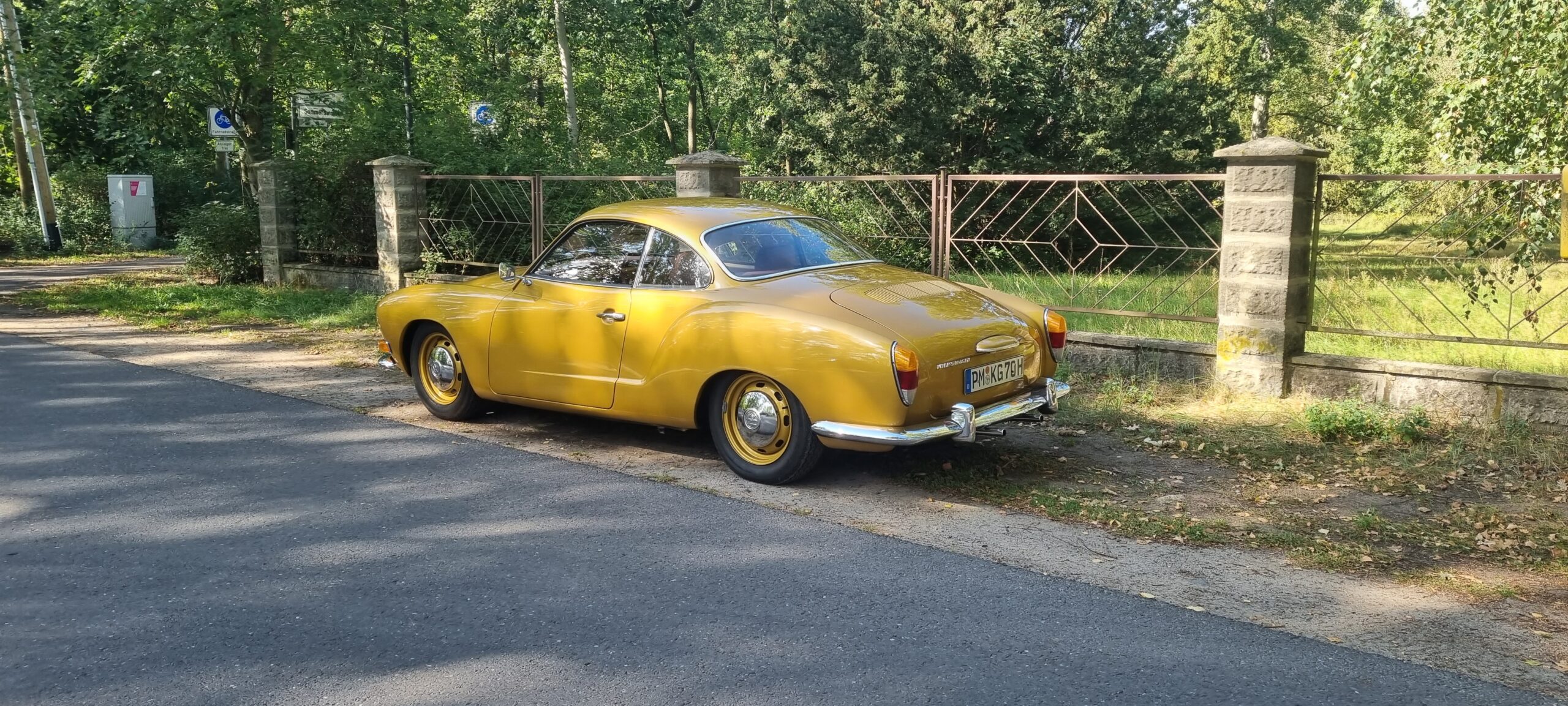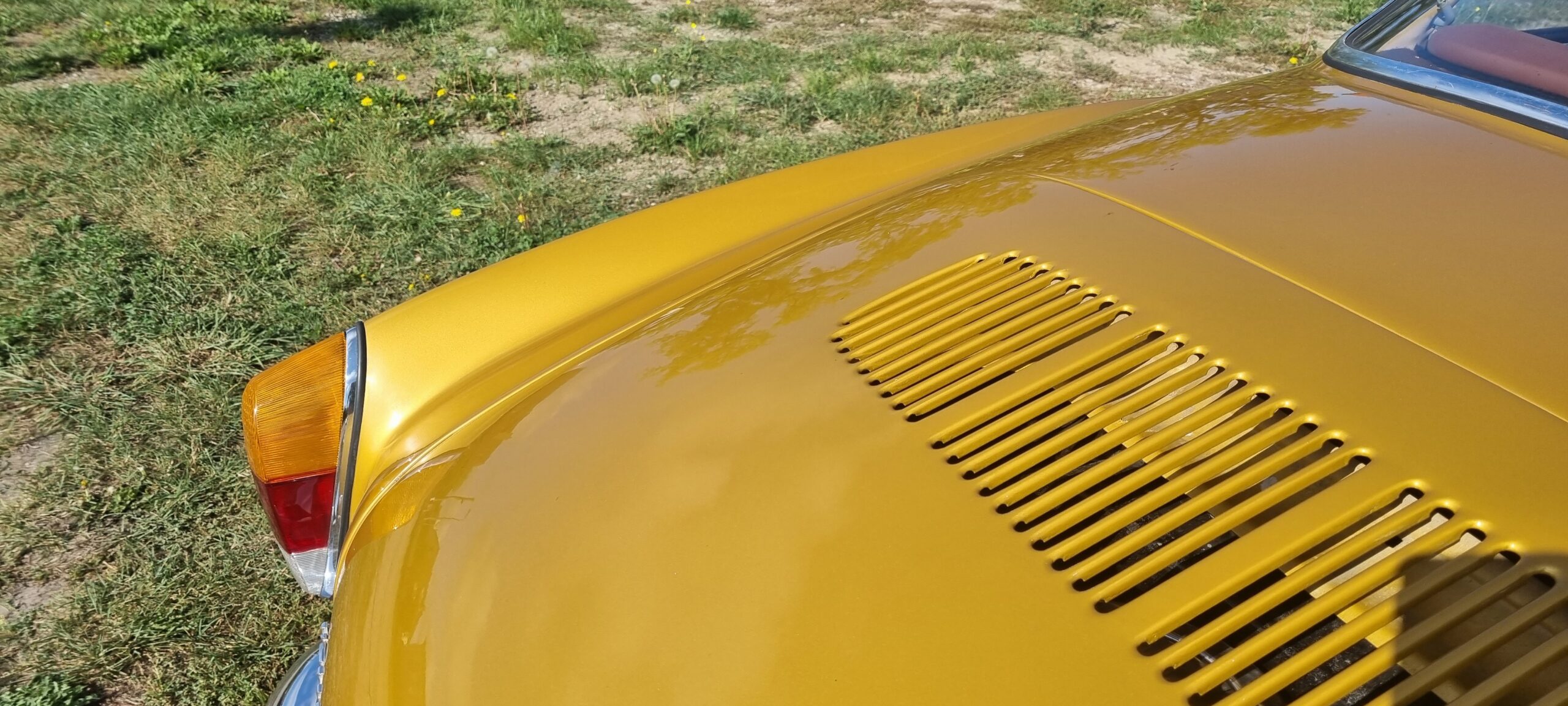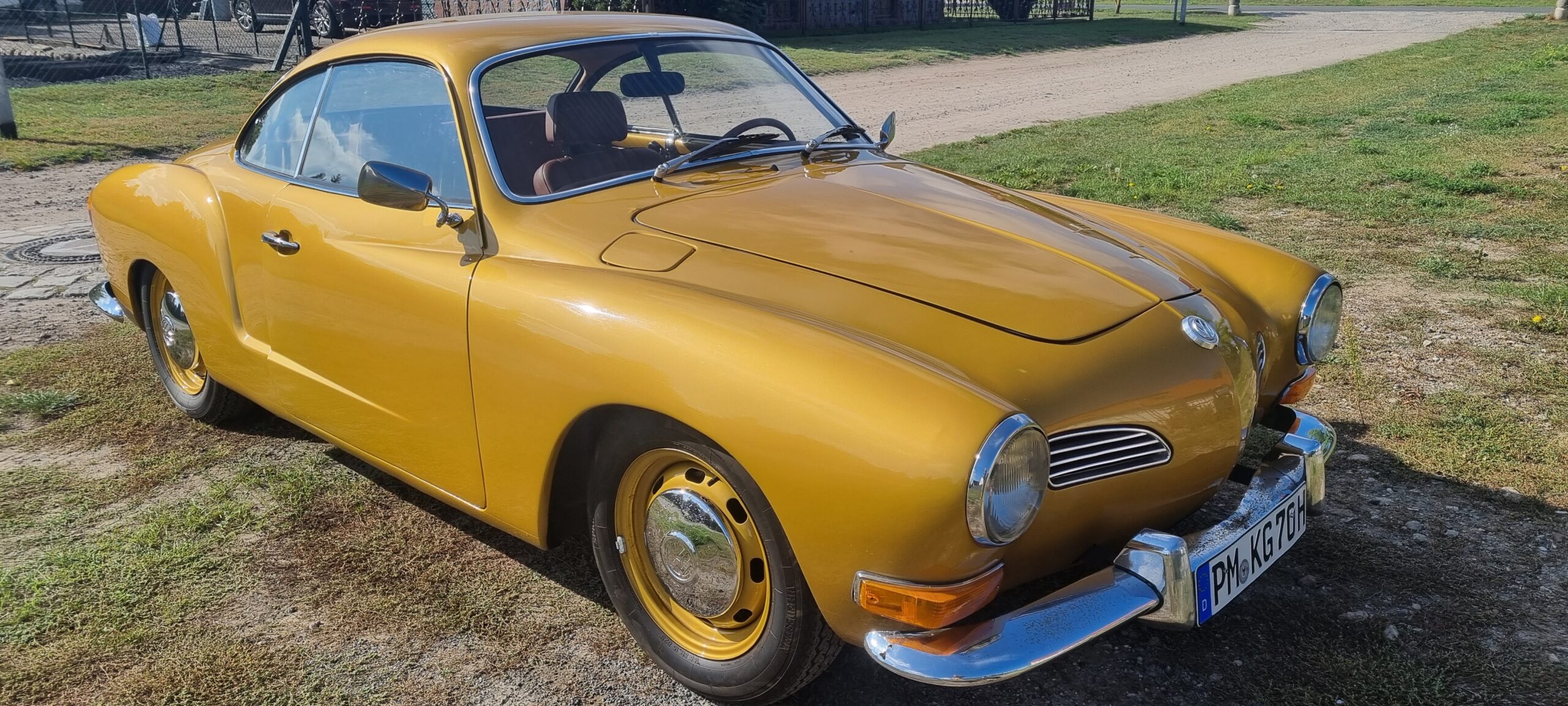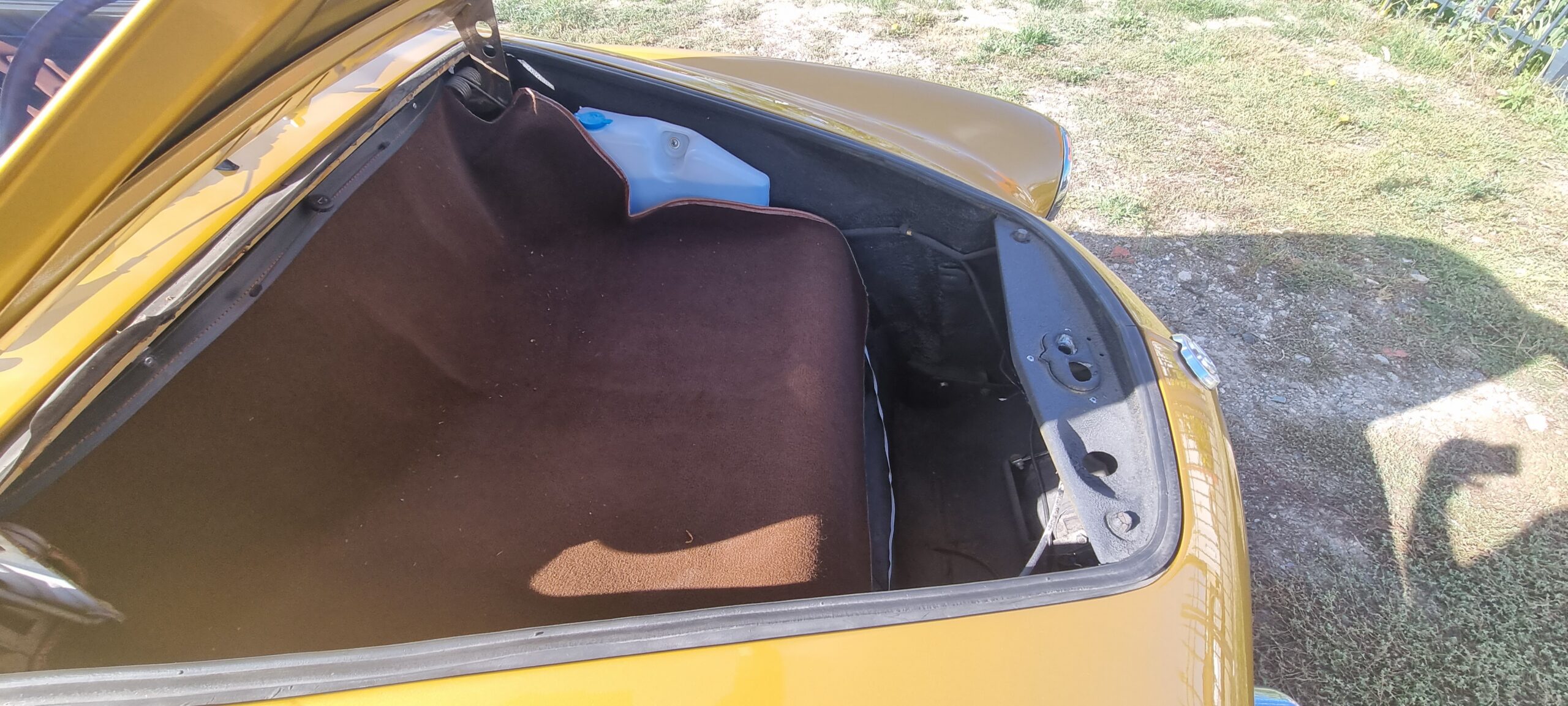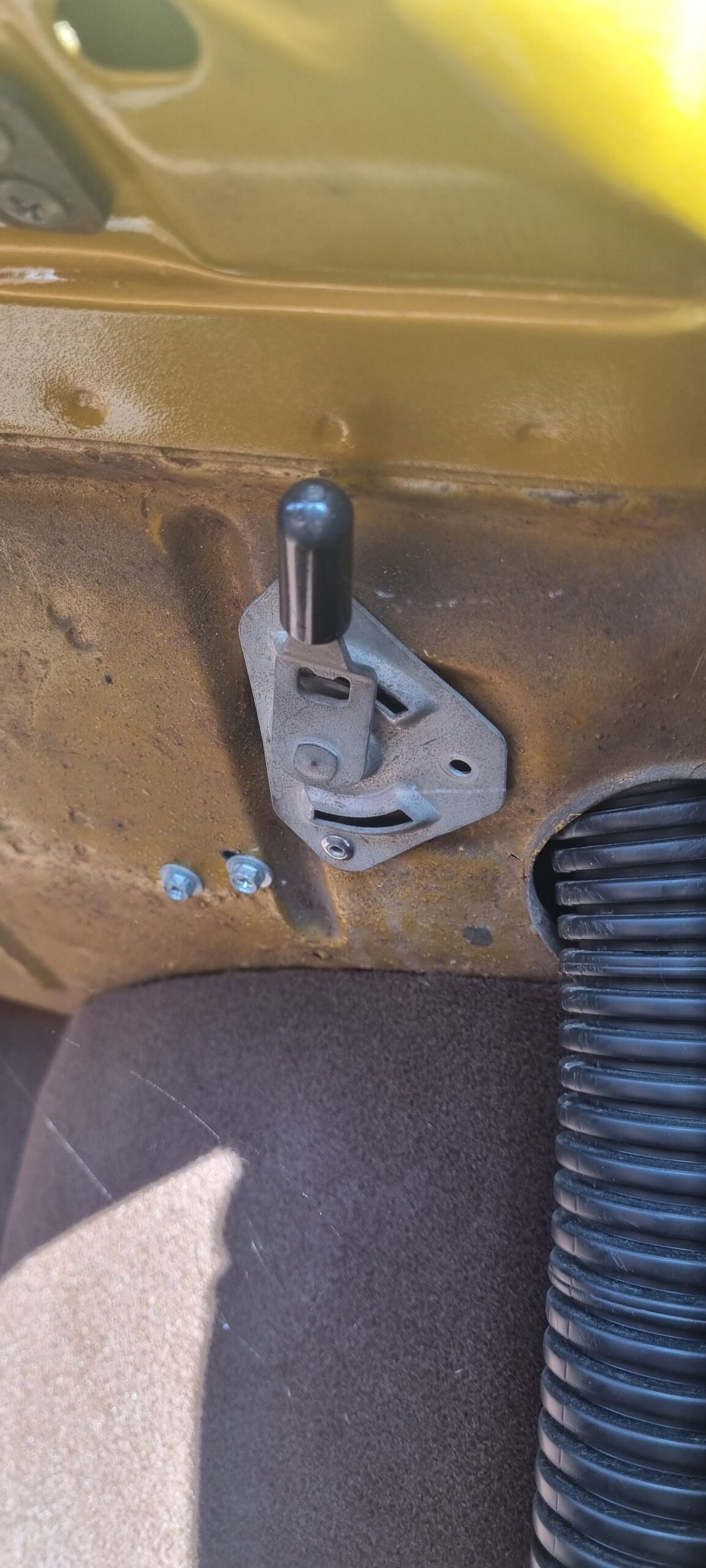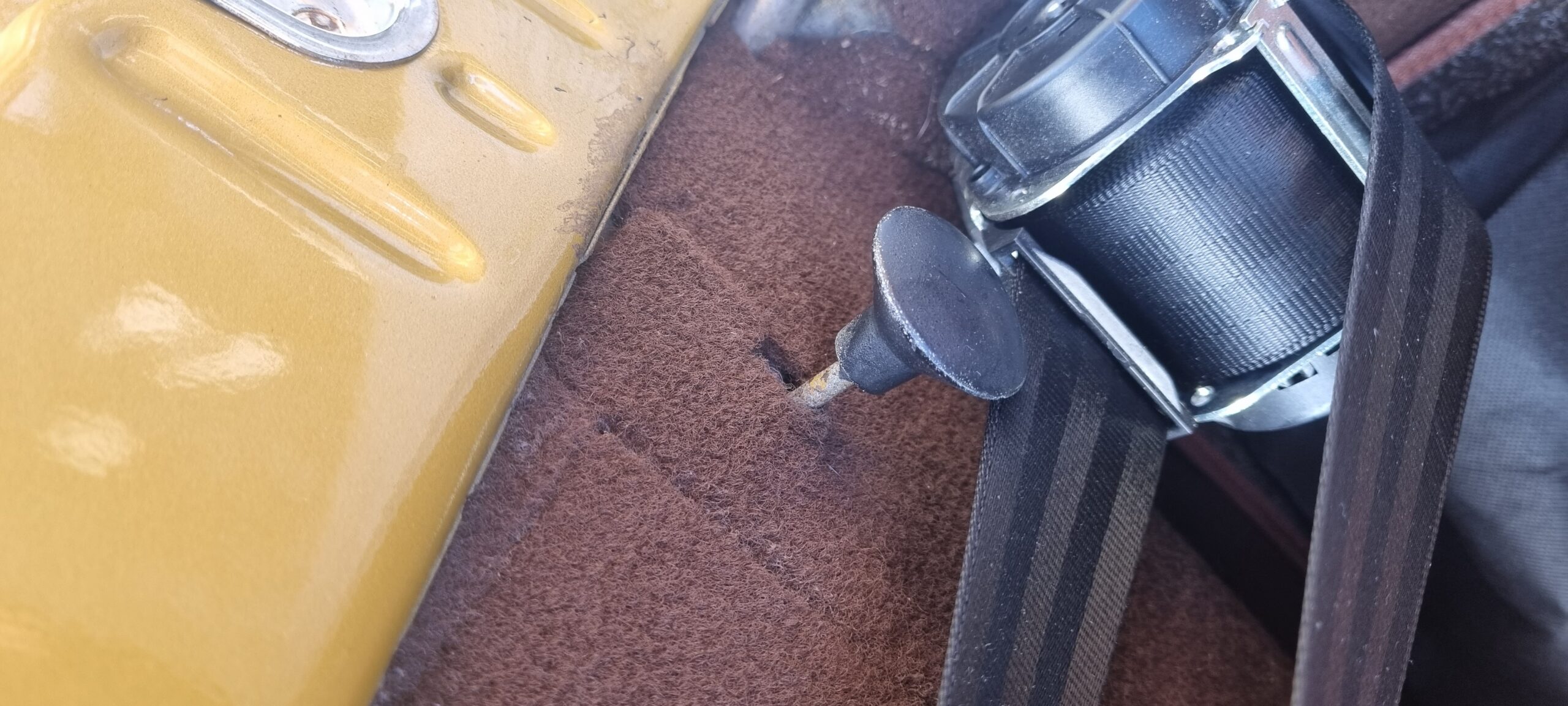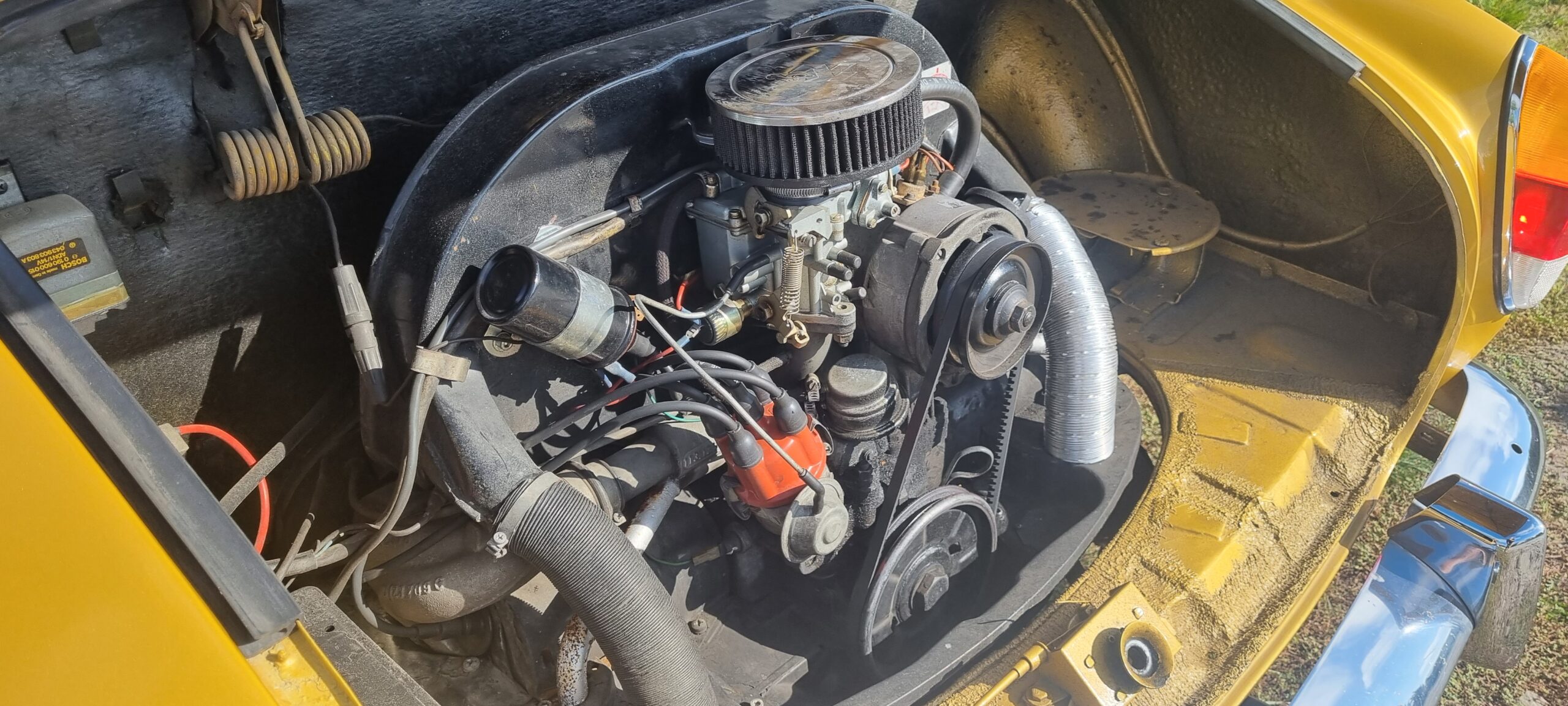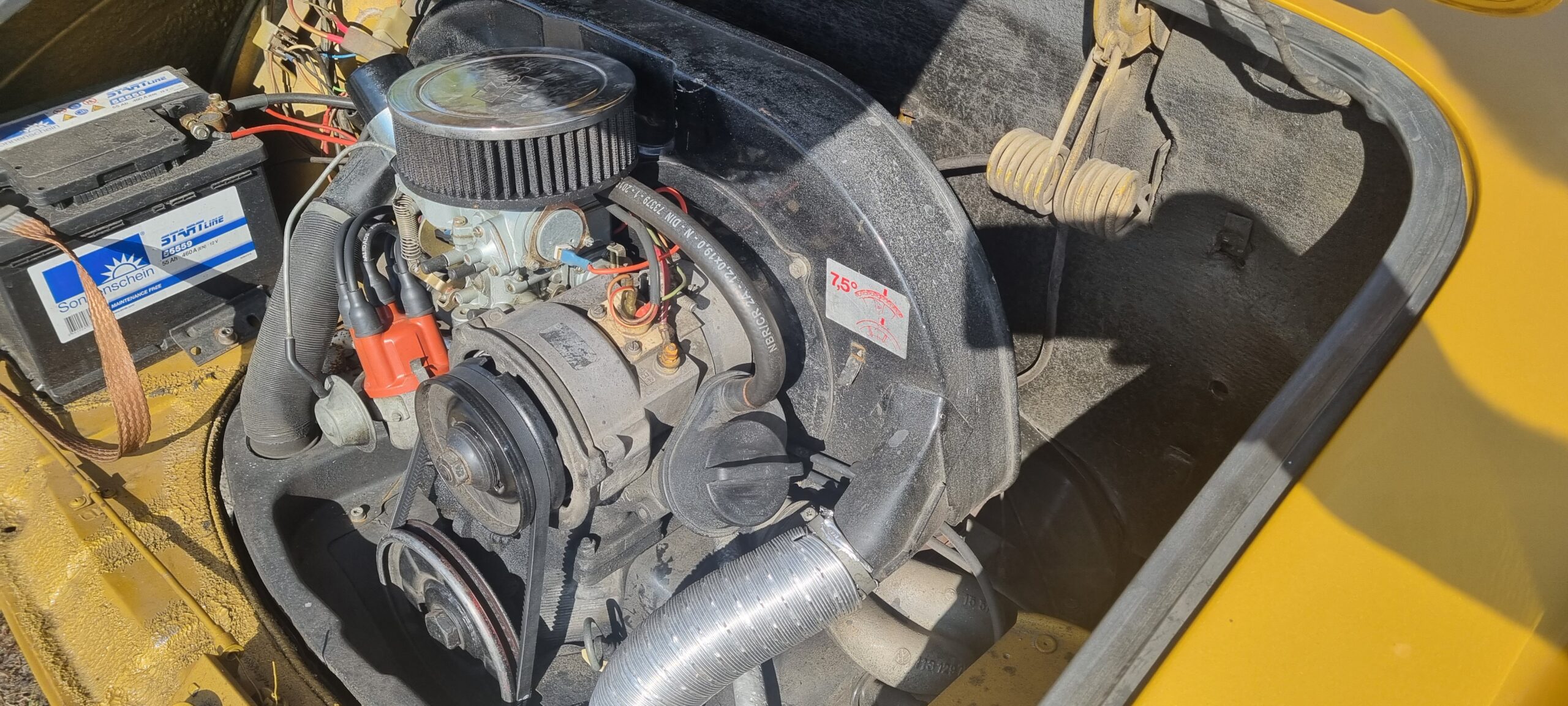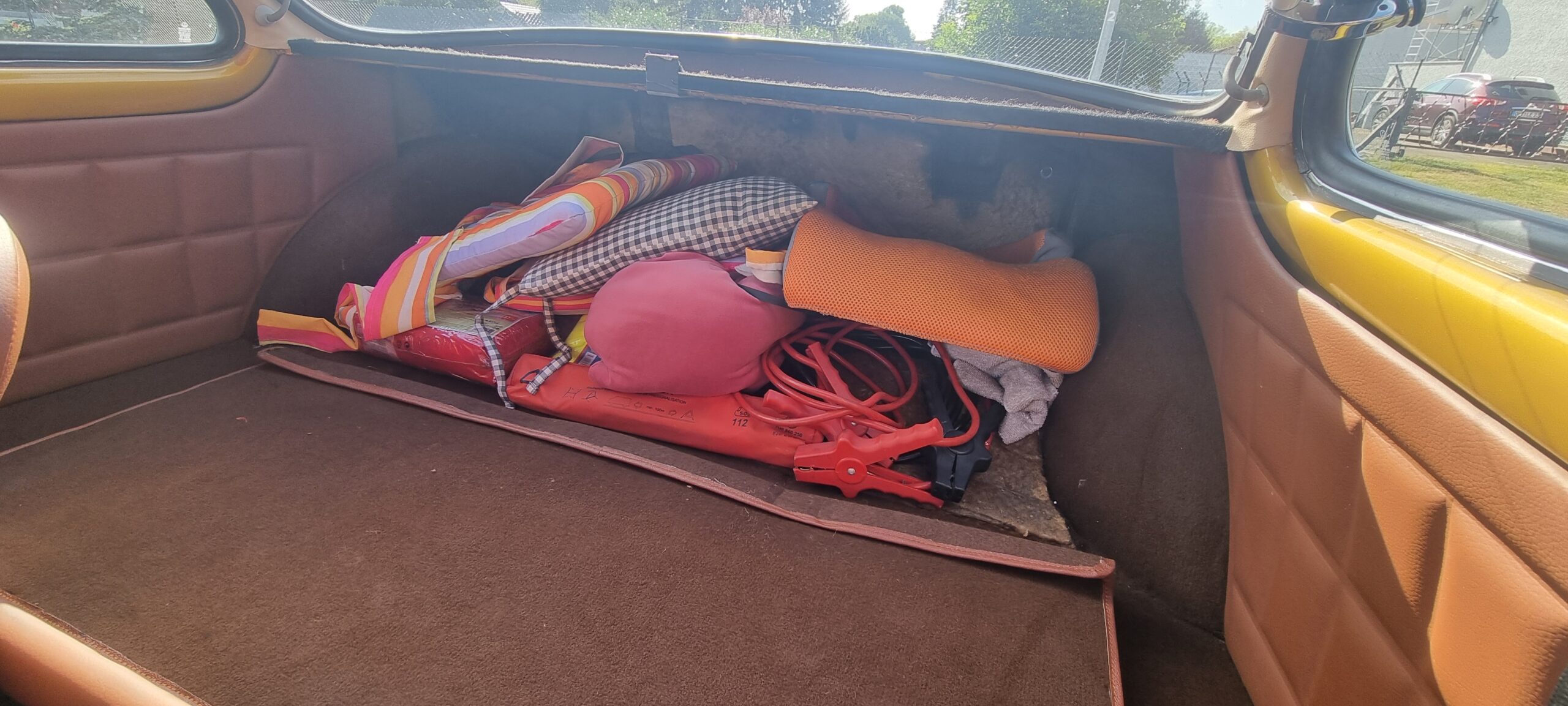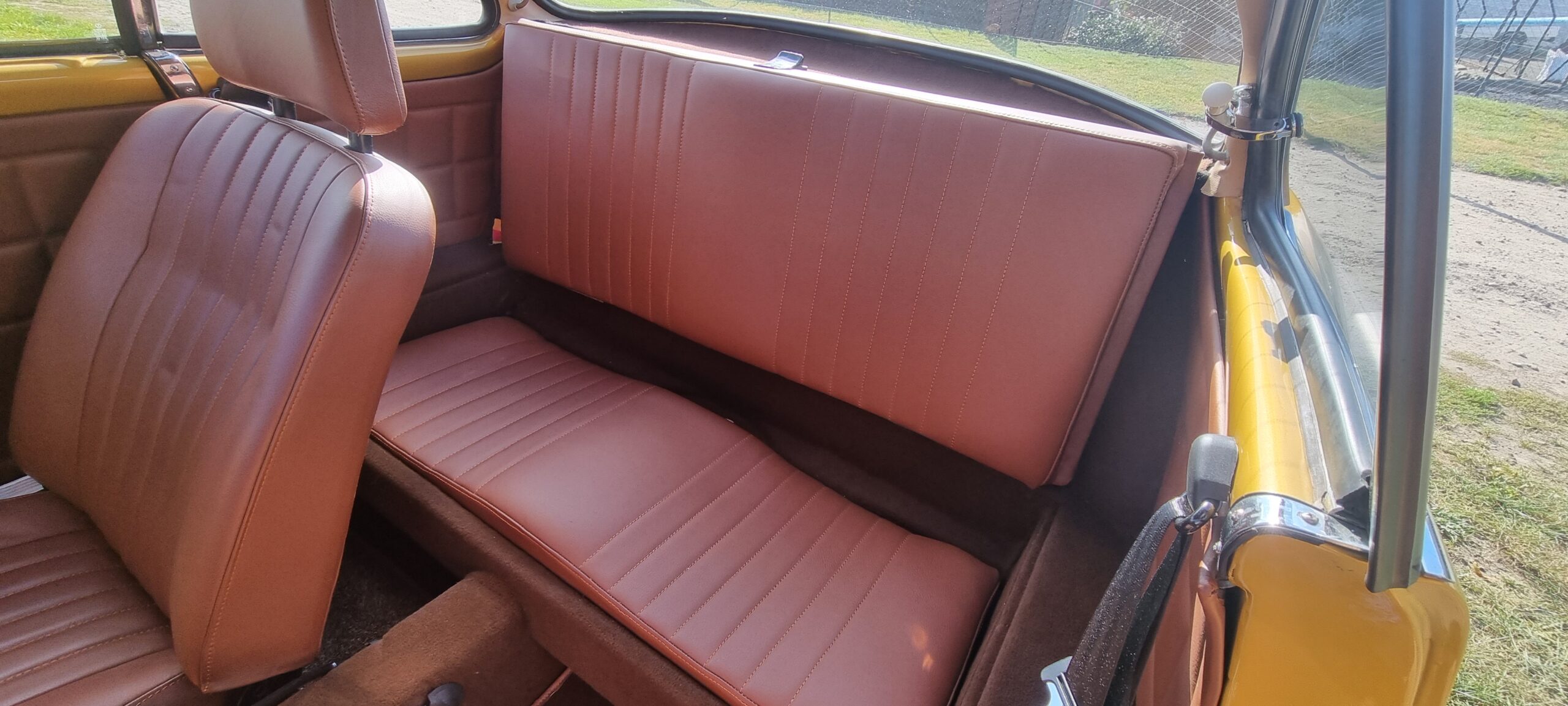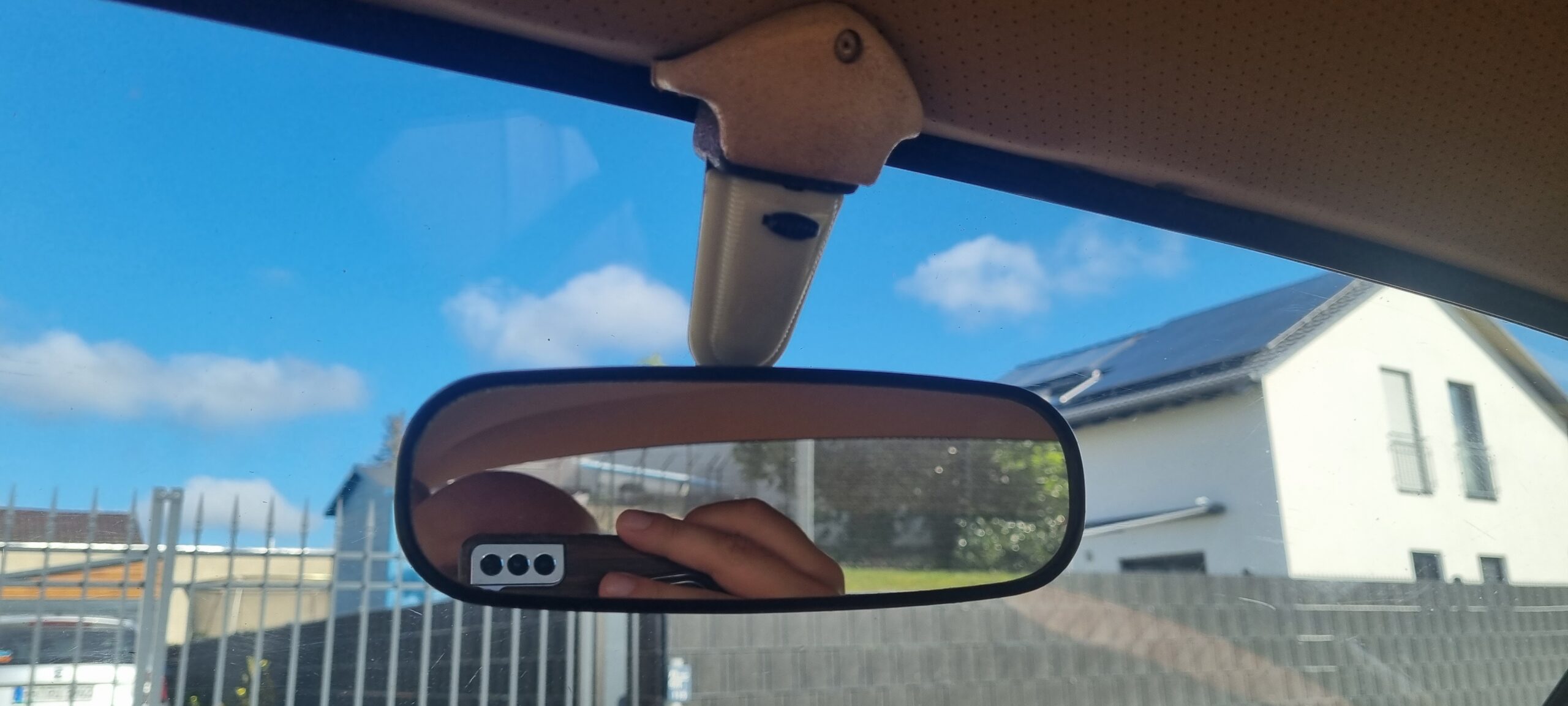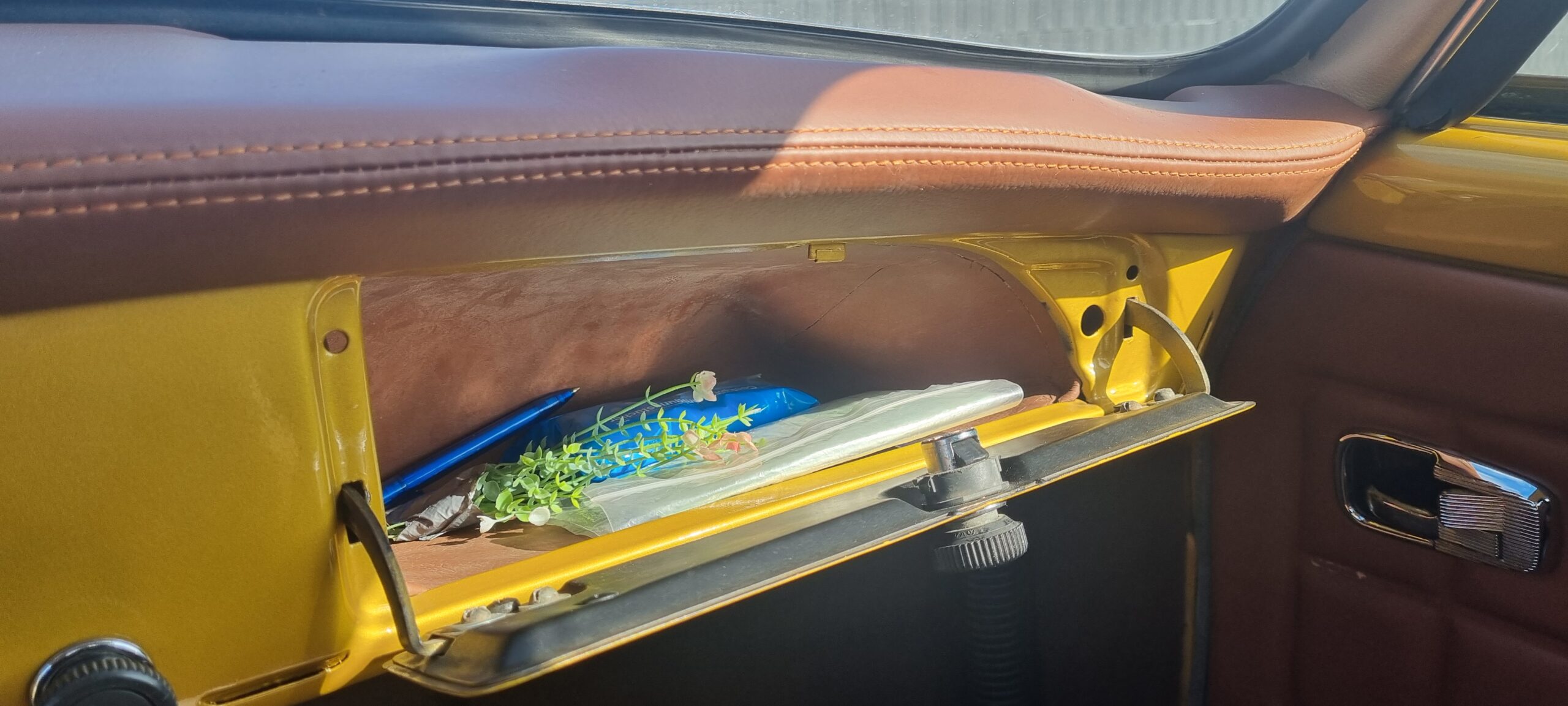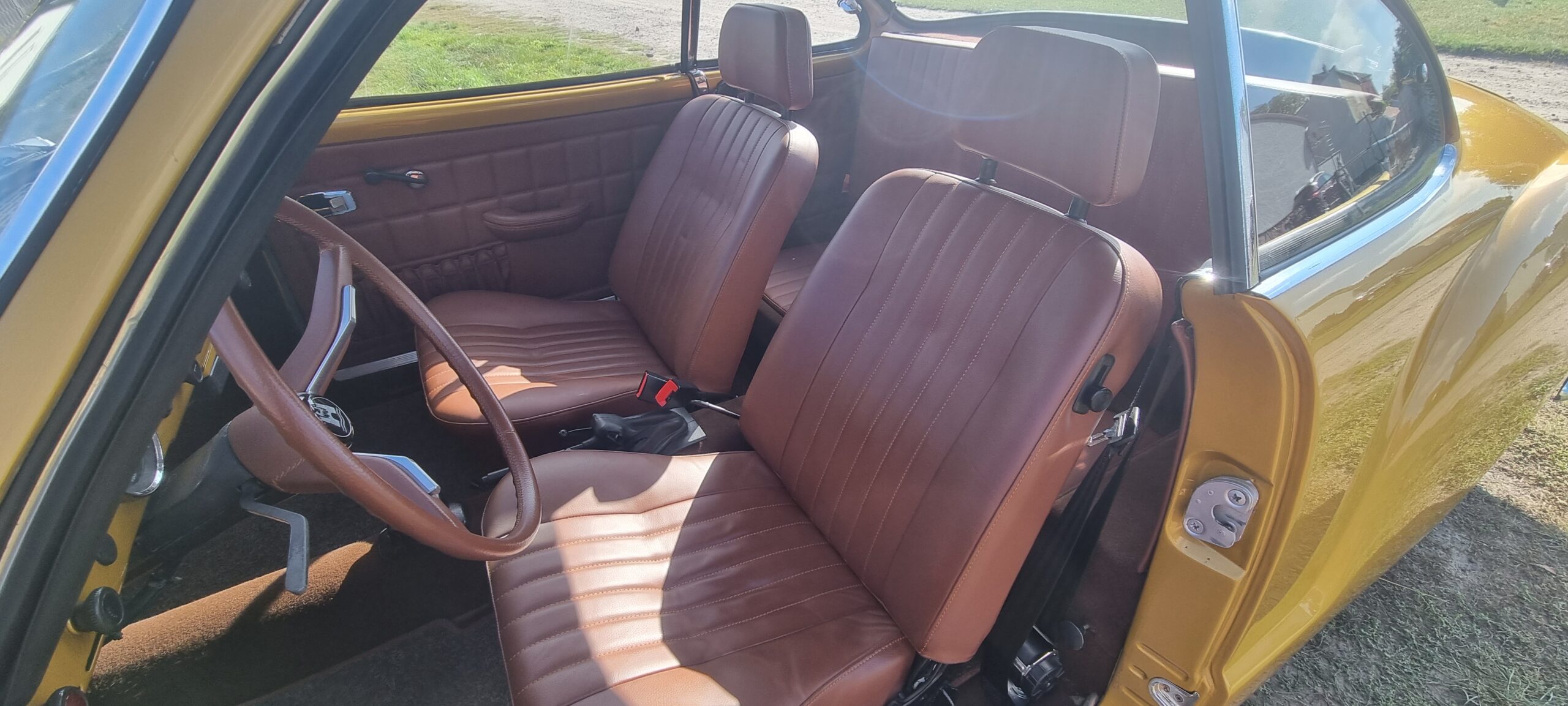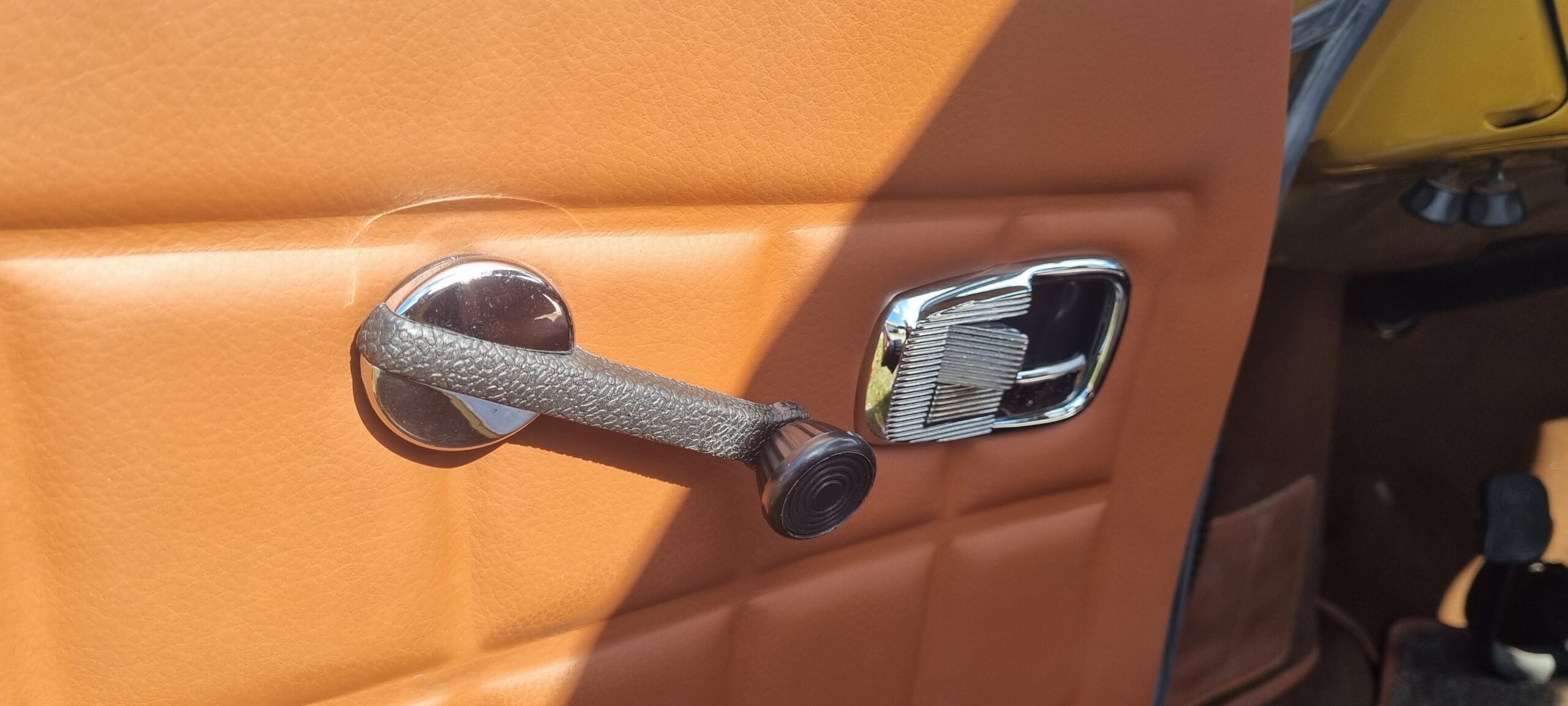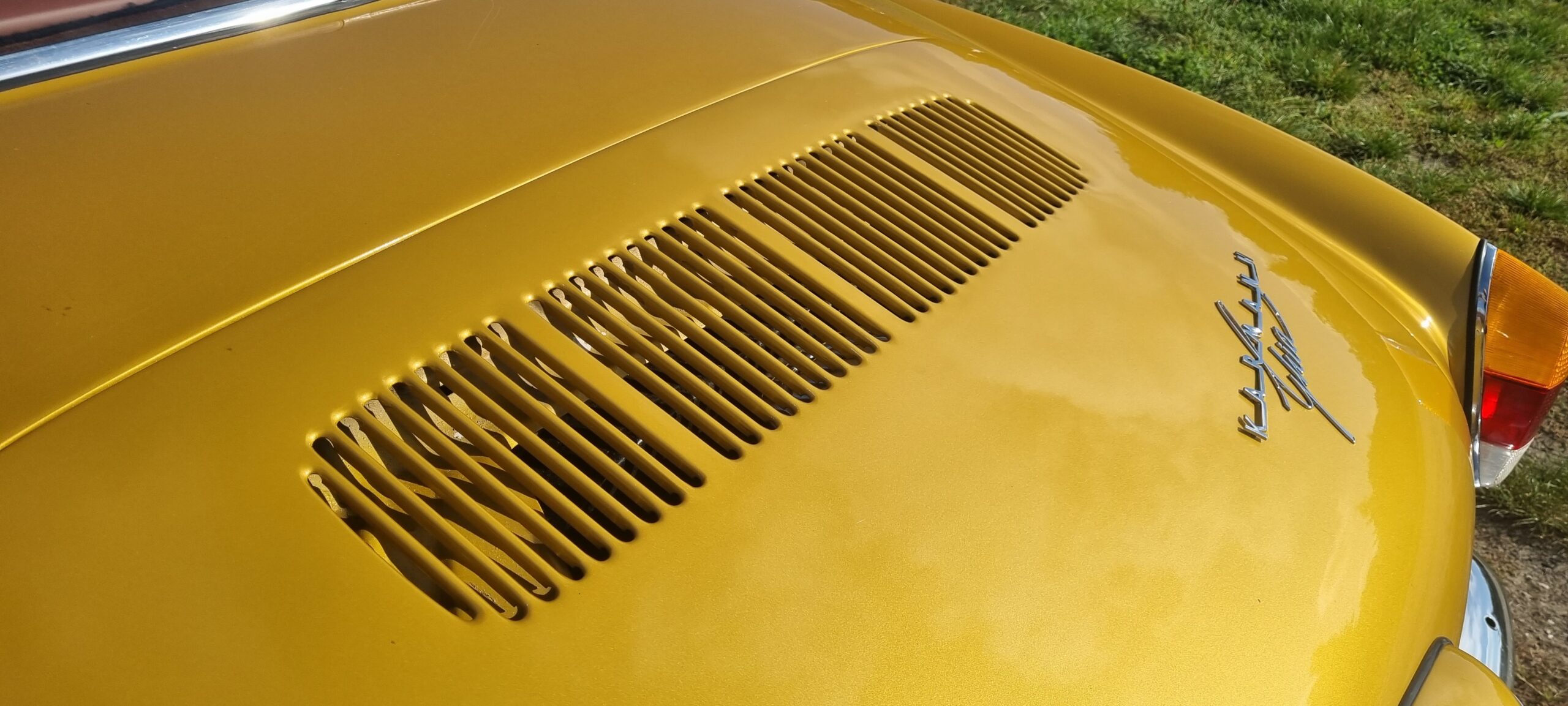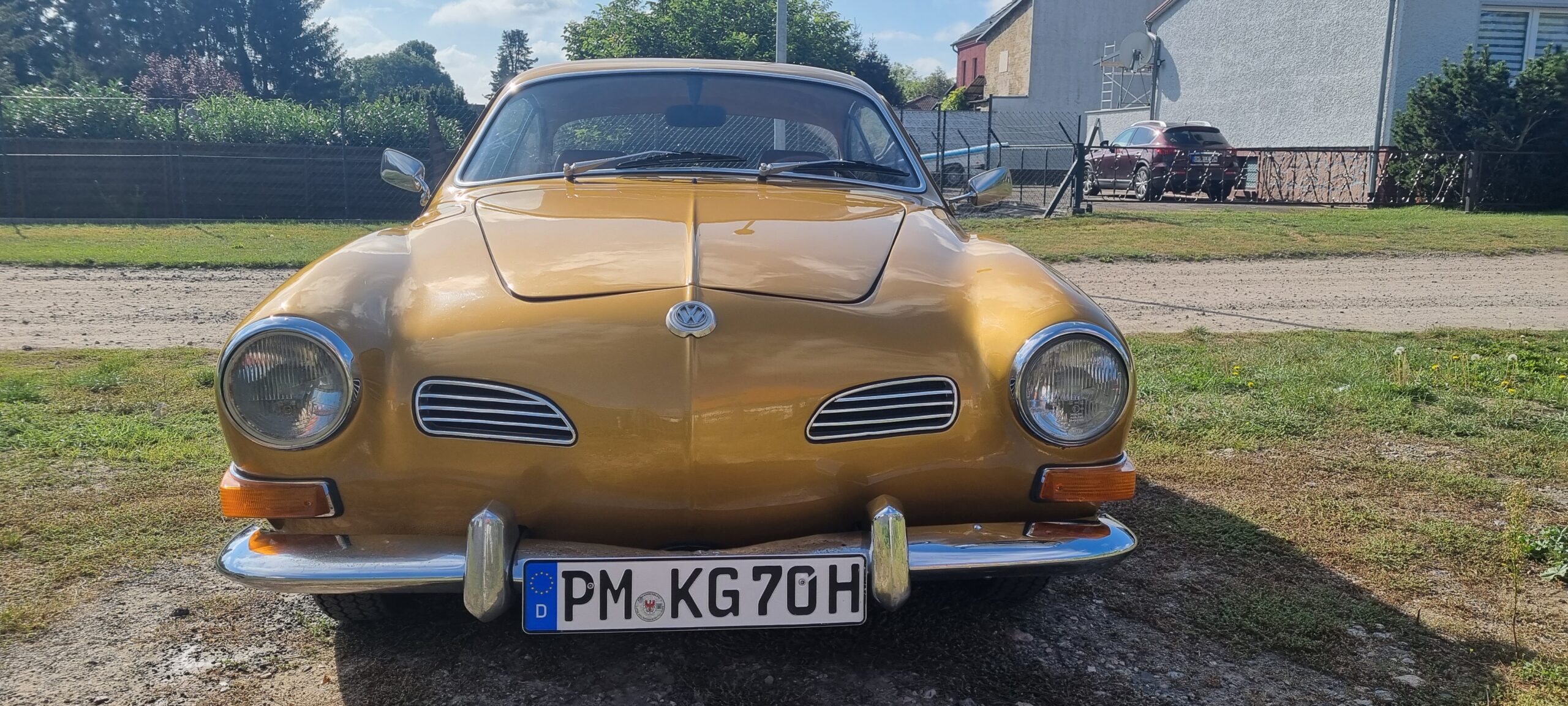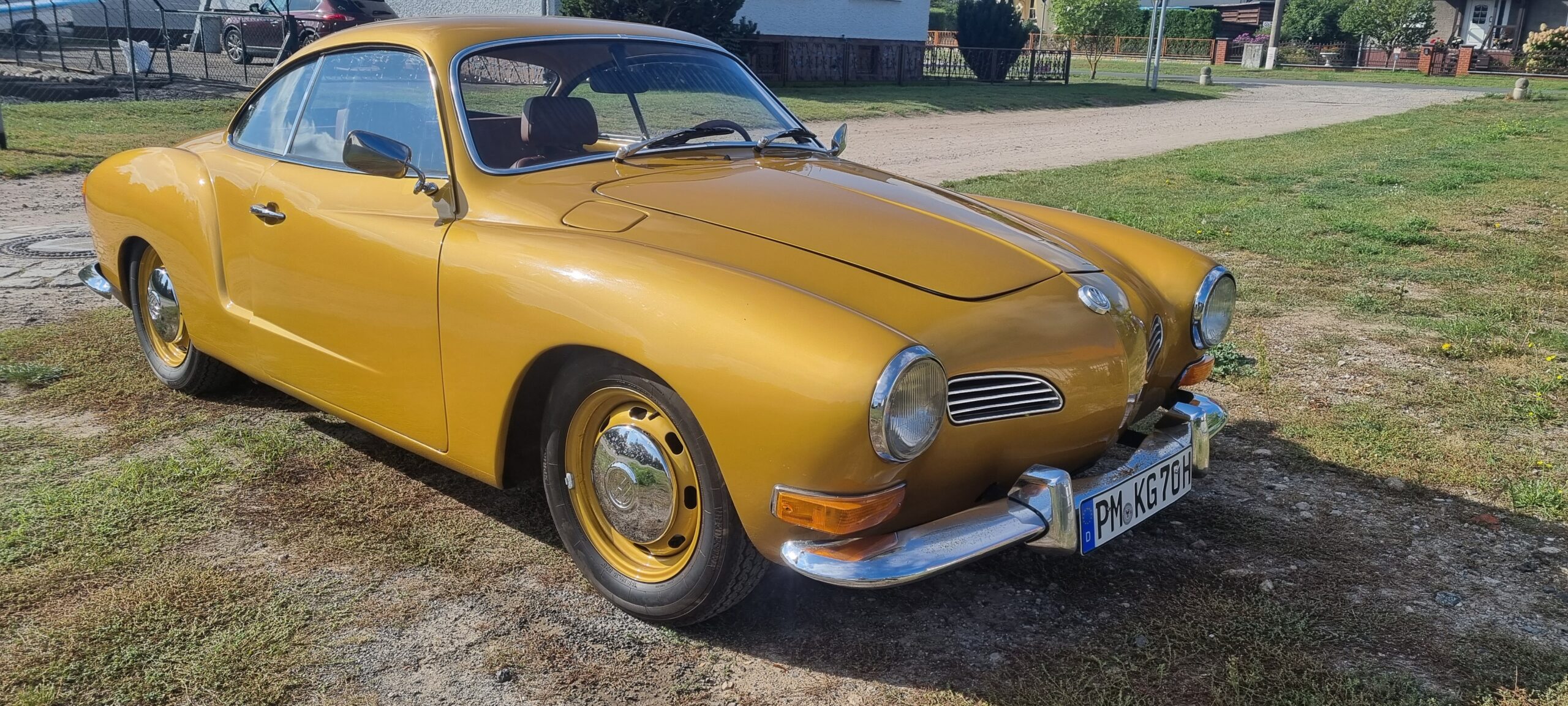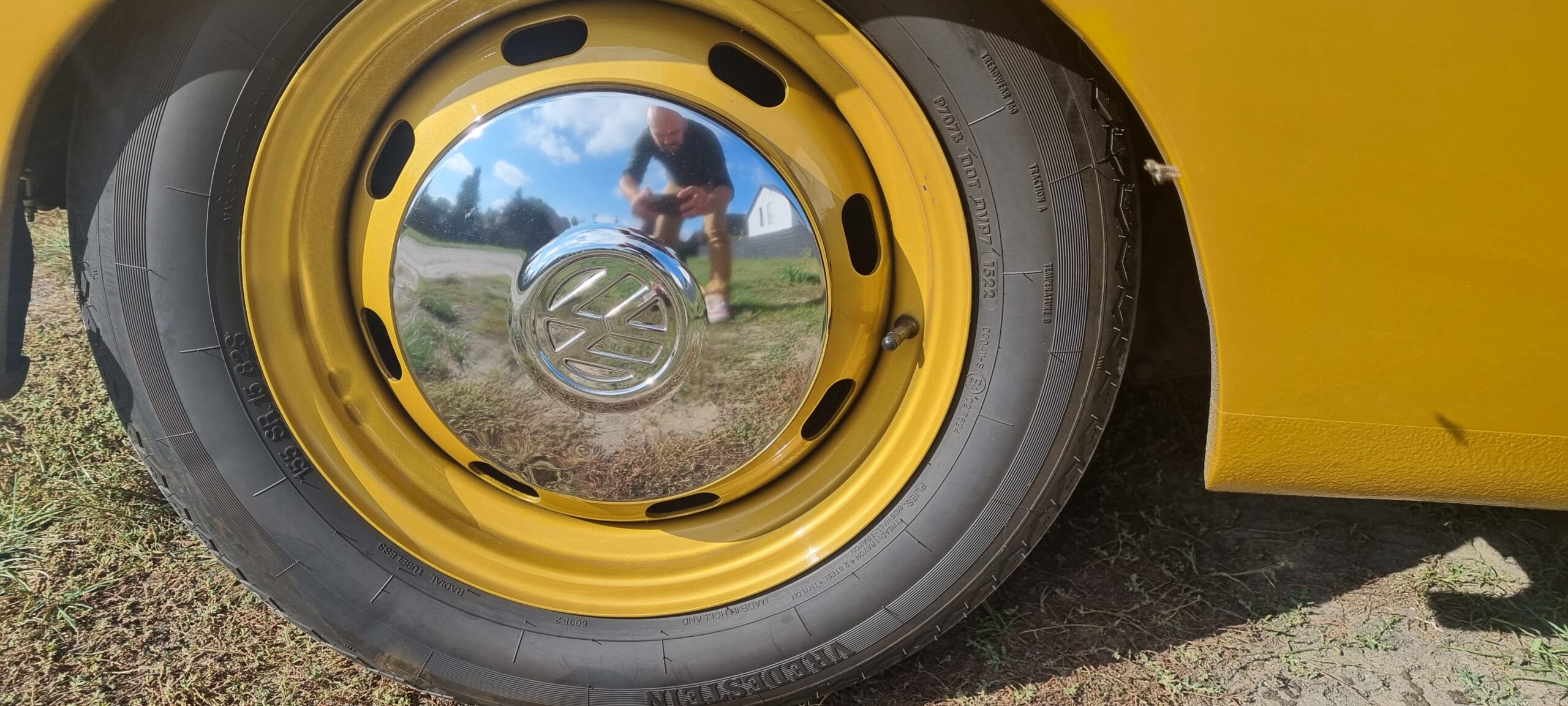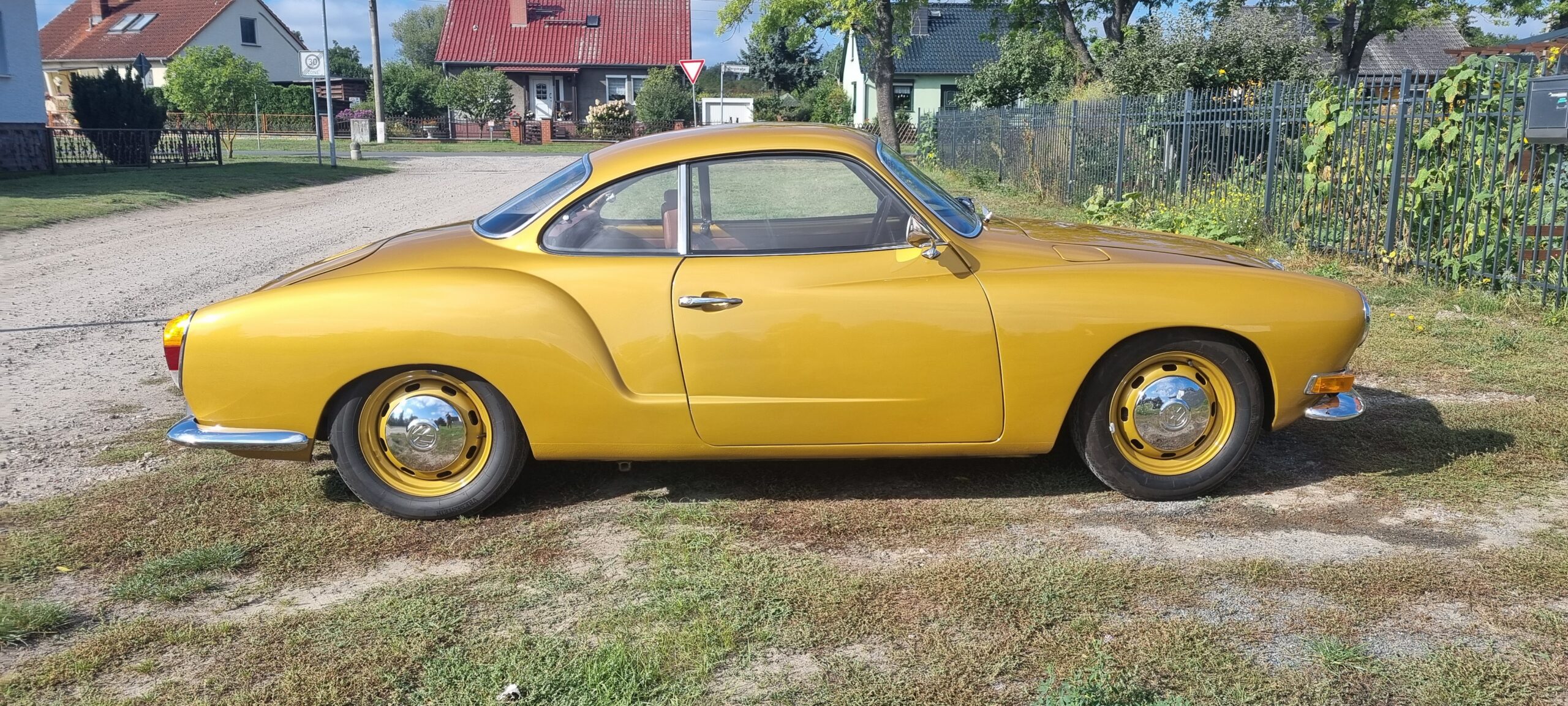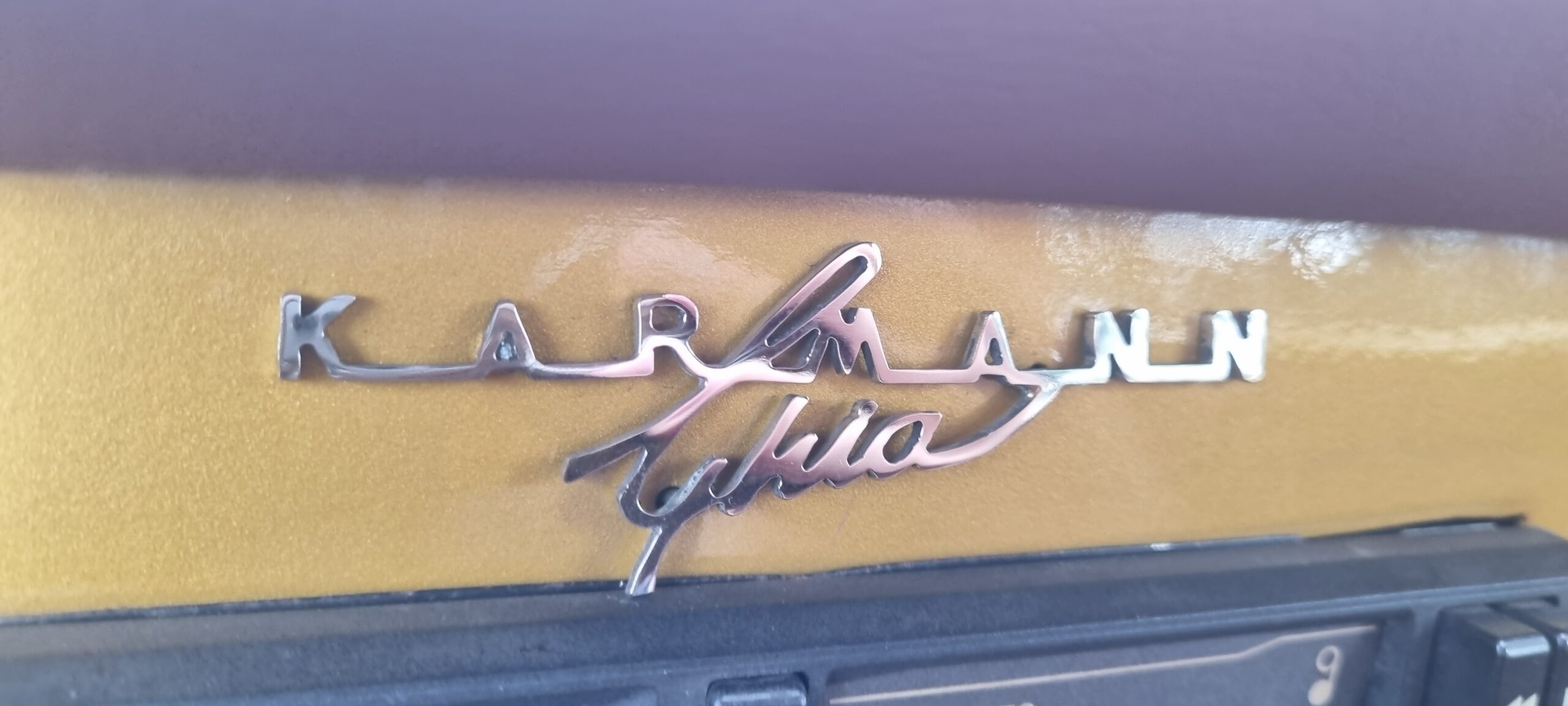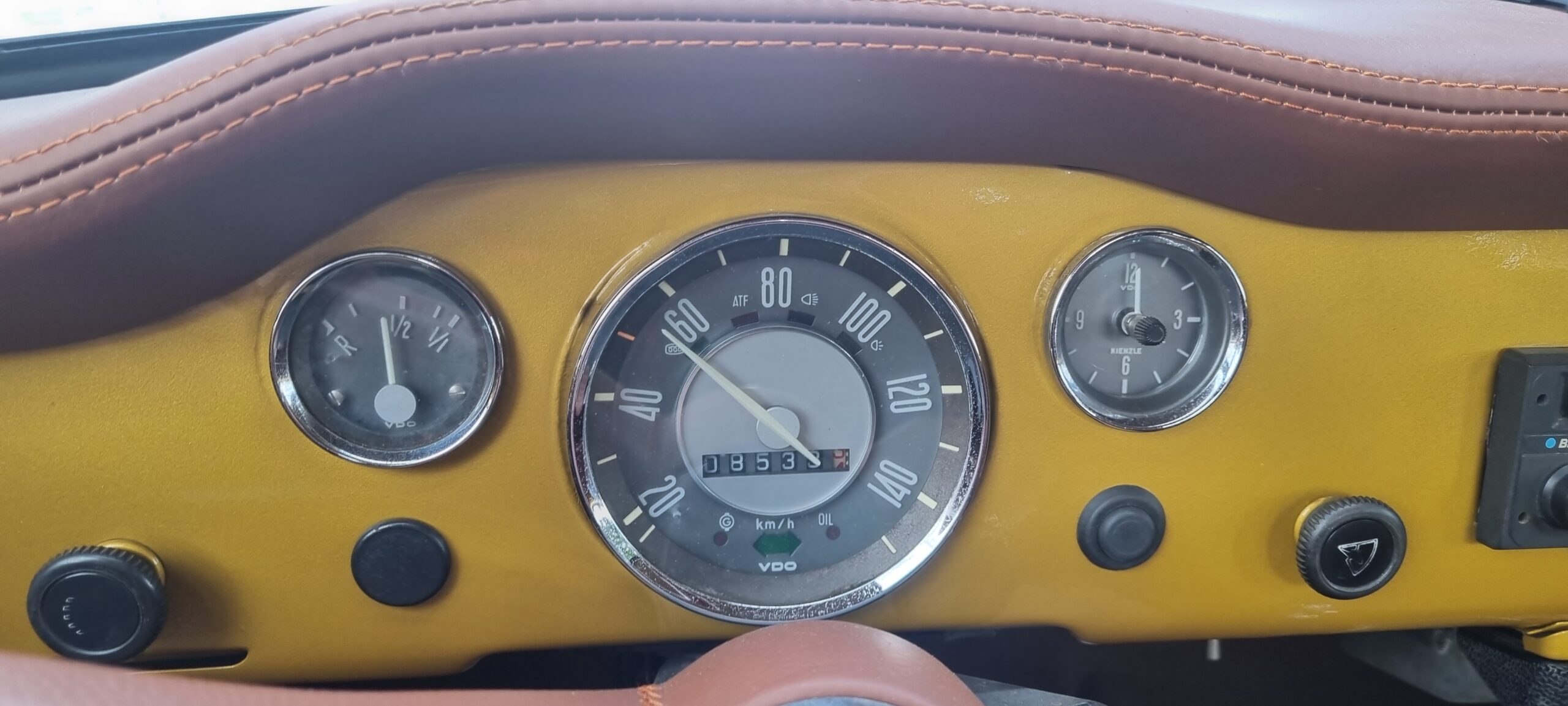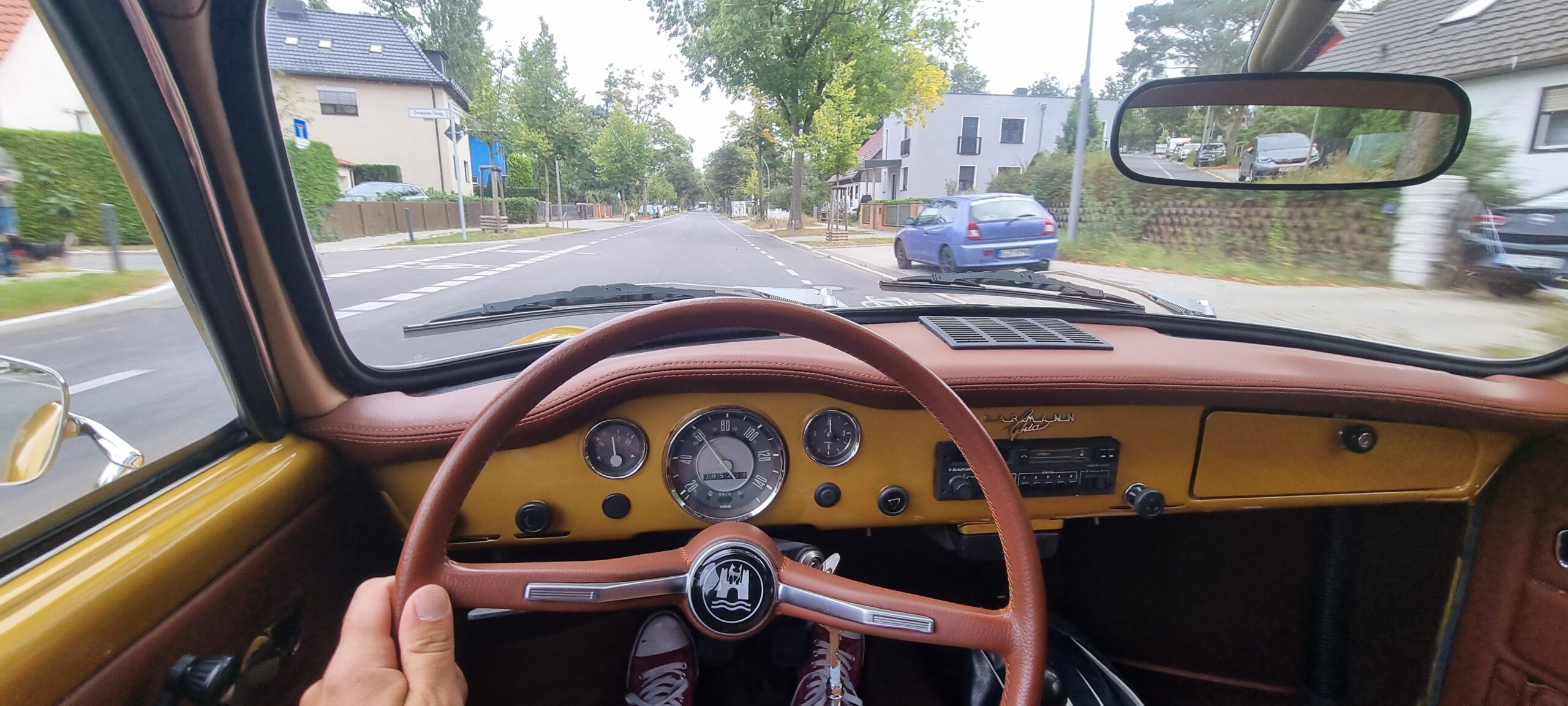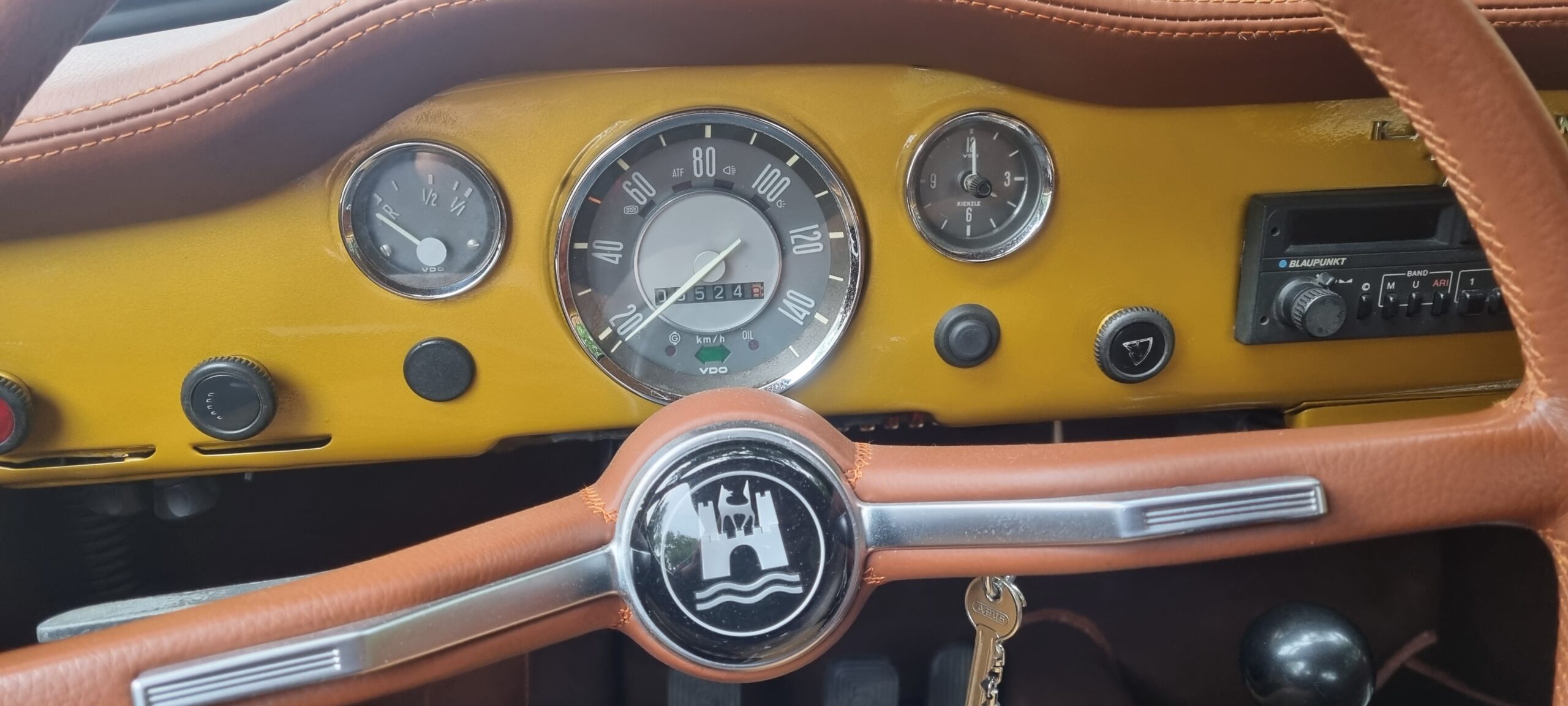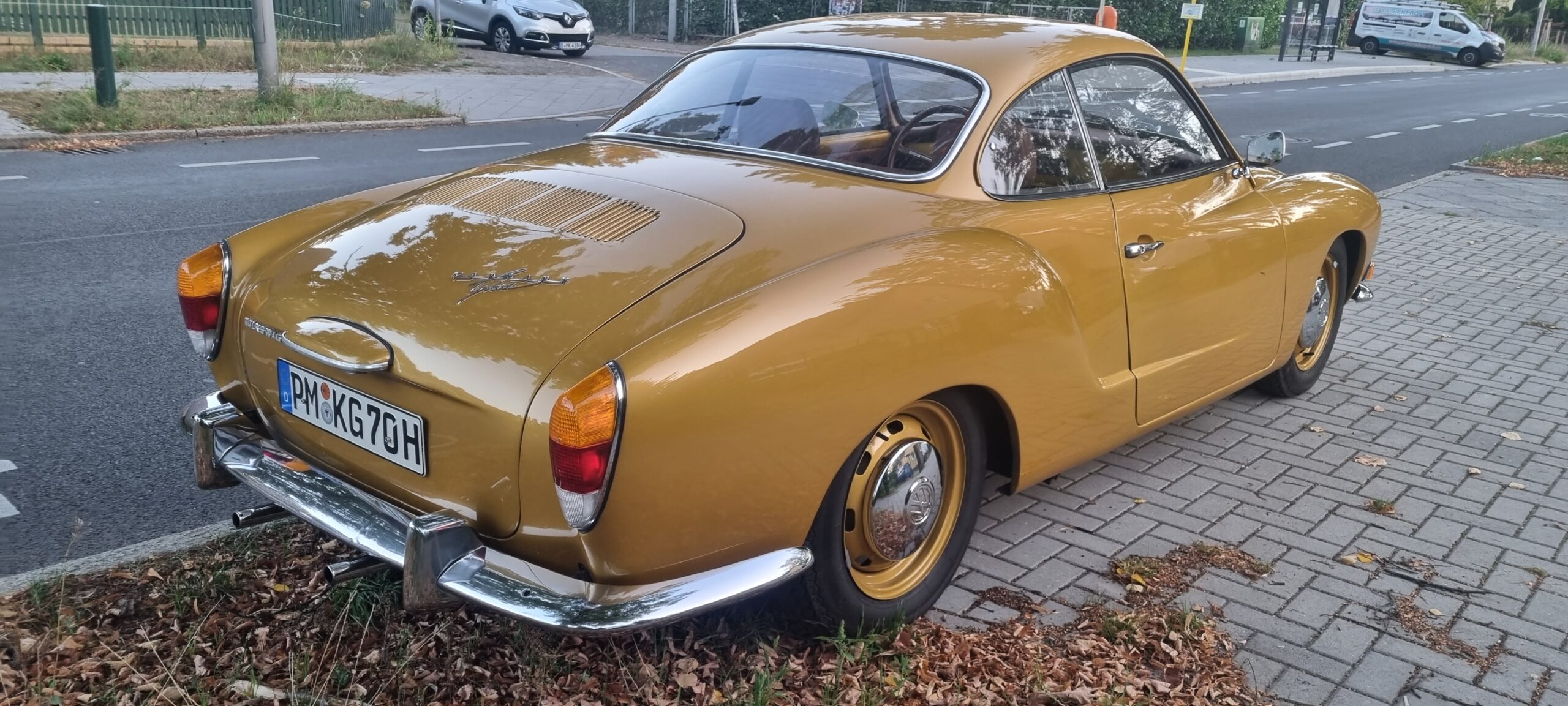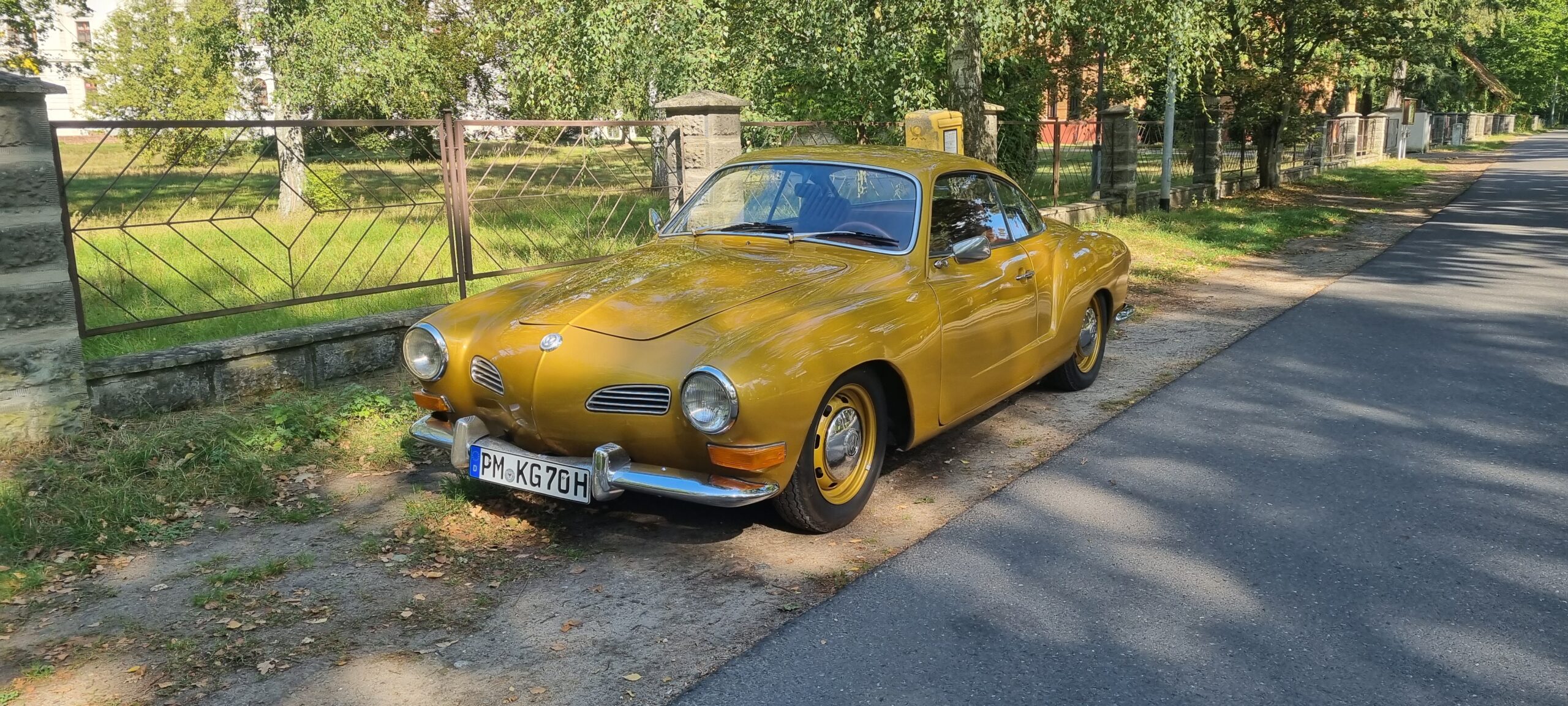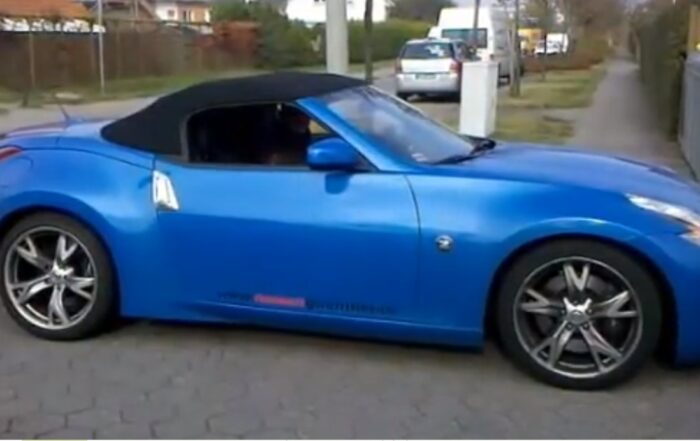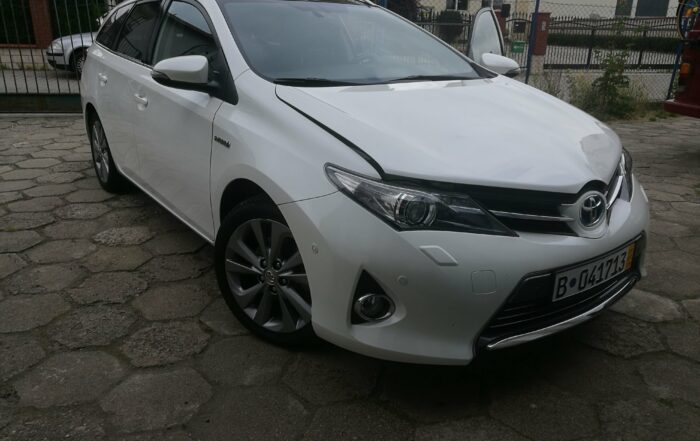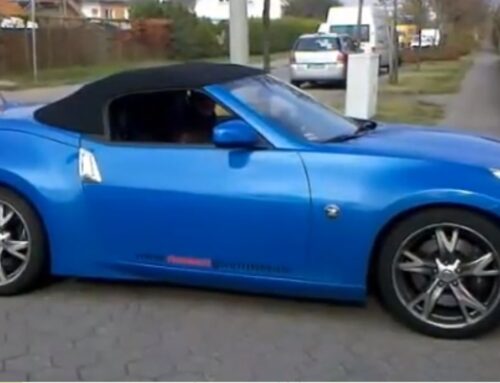Index:
History
Productionsfigures
Design
Model overview
Driving characteristics
Everyday use
Trunk
Spare Parts
Interior
Safty
Maintenance Costs
Fuel Consumptions
Motor Layout
Motor
Transmission
Breaks
Suspension
Common Issues
Driving pleasure
Market offering
Price development
Assessment
Datasheet
POV Video
Test Video
History
The Volkswagen Karmann Ghia Type 14 is a classic car that beautifully combines the elegance of Italian design with the reliable engineering of German automotive craftsmanship. Produced from 1955 to 1974, the Karmann Ghia quickly became an icon of style and sophistication.
The story of the Karmann Ghia began in the early 1950s when Wilhelm Karmann, the owner of the renowned Wilhelm Karmann GmbH coachbuilding company in Germany, approached Volkswagen with a proposal for a sporty and affordable coupe. Karmann had already successfully collaborated with Volkswagen on the convertible version of the Beetle, and he saw the potential to create a more upscale and stylish model based on the same reliable platform.
To bring Karmann’s vision to life, Volkswagen enlisted the help of the Italian design firm, Carrozzeria Ghia. Led by the talented designer Luigi Segre, Ghia was known for its exquisite designs that exuded grace and elegance. The collaboration between Karmann and Ghia resulted in a stunningly beautiful car that seamlessly integrated the aesthetic sensibilities of both the German and Italian manufacturers.
Introduced in 1955, the Karmann Ghia Type 14 was based on the Volkswagen Beetle chassis, sharing its mechanical components and air-cooled flat-four engine. However, the Karmann Ghia featured a unique body shell with flowing lines, a lowered roofline, and a distinctive sweeping rear end that instantly set it apart from other cars of that era.
The early models of the Karmann Ghia retained the same mechanical components as the Beetle, which limited its performance. However, the car’s appeal lay in its style and charm, making it incredibly popular with buyers who desired a sporty and stylish car that was still reliable and affordable.
Over the years, the Karmann Ghia saw several updates and improvements. In 1957, the original 30 horsepower engine was replaced with a more powerful 36 horsepower variant. In 1961, a larger 40-horsepower engine was introduced, further enhancing the car’s performance. Other enhancements included improved front disc brakes, better suspension, and refined interior features.
By the mid-1960s, the Karmann Ghia had become a global success, with production expanding to international markets. The car’s timeless design and quality engineering appealed to individuals across various countries and cultures.
Unfortunately, as the 1970s approached, stricter safety and emission regulations posed challenges for the Karmann Ghia. In 1974, after nearly two decades of production, Volkswagen ceased manufacturing the Karmann Ghia Type 14. The end of the production marked the end of an era for this beloved car.
However, the Karmann Ghia’s legacy lives on. Its timeless design and unique charm continue to captivate collectors and enthusiasts around the world. Today, the Karmann Ghia is highly sought after and cherished by car enthusiasts who appreciate its blend of elegance, reliability, and historical significance.
The Volkswagen Karmann Ghia Type 14 remains an iconic symbol of automotive design and engineering. Its collaboration between German and Italian manufacturers created a car that stands the test of time, embodying both grace and performance. From its humble beginnings as a concept to its enduring legacy, the Karmann Ghia remains an enduring testament to the artistry and craftsmanship of the automotive world.
Productionsfigures
The Volkswagen Karmann Ghia Type 14 was produced by German automaker Volkswagen between 1955 and 1974. During this period, a total of approximately 445,000 units of the Karmann Ghia Type 14 were manufactured.
Design
The designer of the Volkswagen Karmann Ghia Type 14 was Luigi Segre of the Italian design firm Carrozzeria Ghia. The inspiration for the Karmann Ghia’s design came from the iconic Volkswagen Beetle, which was known for its simplicity and reliability. Segre aimed to create a more stylish and sporty version of the Beetle.
In terms of design language, the Karmann Ghia adopted a sleek and timeless aesthetic. It featured smooth curves, a low and wide stance, and a streamlined profile. The car had a distinctive silhouette with a rounded front end, flowing roofline, and a gentle slope leading to the rear. The overall design was clean and elegant, with an emphasis on simplicity and aerodynamics.
The Karmann Ghia’s interior also reflected the same design philosophy. It had a minimalist approach, featuring a clean dashboard layout, simple gauges, and a functional yet stylish interior.
Overall, the Karmann Ghia Type 14’s design language blended elements of the Beetle’s practicality with a more refined and sophisticated look, making it a classic and timeless car design.
Model overview
The Volkswagen Karmann Ghia Type 14 has undergone several variations throughout its production. Here are some notable ones:
1. Coupe: The original and most common version of the Karmann Ghia Type 14 is the coupe model. It featured a sleek two-door body style designed by Italian coachbuilder Ghia and was produced from 1955 to 1974. The coupe model is known for its classic curves, chrome details, and elegant design.
2. Convertible: In addition to the coupe, a convertible version of the Karmann Ghia was introduced in 1957. The convertible offered open-top driving experience with a manually-folding soft top. The convertible was produced until 1974 and is highly sought after by collectors due to its rarity and timeless appeal.
3. Lowlight: Produced from 1955 to 1959, the Karmann Ghia Lowlight models had distinct features like a lower and flatter front windshield, smaller rear window, and unique dash design. These early models are often considered more exclusive and collectible due to their limited production.
4. Razor-Edge: In 1961, the Karmann Ghia Type 34, also known as the Razor-Edge, was introduced. This was a completely different model from the Type 14, featuring a more angular design influenced by the contemporary Volkswagen Type 3. It had a larger body, wraparound windshield, and a more spacious interior. The Type 34 was produced until 1969 and had a more limited production compared to the Type 14.
5. Electric Conversion: Several enthusiasts have converted their Karmann Ghia Type 14 into electric cars. These conversions involve removing the original combustion engine and replacing it with an electric motor and battery pack. Electric Karmann Ghias offer a unique blend of classic aesthetics and modern eco-friendly technology.
6. Modified and Customized Versions: Over the years, many Karmann Ghia owners have customized their vehicles to suit their preferences. These modifications can range from installing aftermarket performance parts to radically transforming the vehicle’s exterior and interior design. Customized Karmann Ghias often reflect the owner’s personal taste and creativity.
It is worth noting that while these variations existed, some were produced in limited quantities and may be relatively harder to find compared to the standard Type 14 coupe and convertible models.
Driving characteristics
The Volkswagen Karmann Ghia Type 14, produced from 1955 to 1974, is known for its unique combination of stylish design and reliable Volkswagen engineering. While it shares many mechanical components with the popular Beetle of its time, the Karmann Ghia offers a distinct driving experience. Here are some of its driving characteristics:
1. Handling: The Karmann Ghia’s lightweight construction and rear-engine layout provide a balanced and predictable driving experience. Its low center of gravity enhances stability around corners, making it responsive and enjoyable to drive.
2. Comfort: Despite its sporty appearance, the Karmann Ghia offers a comfortable ride. The suspension system effectively absorbs bumps and road imperfections, ensuring a smooth journey.
3. Acceleration: The Karmann Ghia is not known for its speed, as its primary focus lies in style rather than performance. The vehicle’s modest engine options provide sufficient power for city driving and moderate acceleration on open roads.
4. Braking: Equipped with reliable drum brakes, the Karmann Ghia offers sufficient stopping power. However, due to the car’s weight distribution, it’s essential to adapt to the rear-engine layout when applying brakes to avoid any potential instability.
5. Steering: The Karmann Ghia’s steering is light and responsive, allowing for easy maneuverability, especially in urban settings. The driver enjoys a good amount of feedback from the road, enhancing the overall driving experience.
6. Engine and Transmission: The Karmann Ghia initially came with a 1.2-liter engine, which was later replaced by larger 1.3 and 1.6-liter engines. These air-cooled engines, derived from the Volkswagen Beetle, offer decent fuel efficiency and are known for their durability. The Karmann Ghia comes with a four-speed manual transmission, which is smooth and well-matched to the engine’s output.
7. Noise and Vibration: The Karmann Ghia experiences typical noise and vibration associated with older air-cooled engines. While some enthusiasts enjoy the distinctive sound, others may prefer a quieter cabin environment.
Everyday use
The Volkswagen Karmann Ghia Type 14 is a classic car known for its sleek design and timeless appeal. While it may not be the most practical choice for everyday use, it can still handle daily driving with some considerations.
One of the main factors to consider is the Karmann Ghia’s size. As a two-door coupe, it offers limited space for passengers and cargo. The rear seats are small, suitable for children or occasional use, but may not be comfortable for adults on longer journeys. Similarly, the trunk space is limited, making it challenging to carry large or bulky items.
In terms of performance, the Karmann Ghia is not a high-performance car. It typically comes with a modest engine, and its focus is more on style and aesthetics rather than speed or power. Therefore, it may not be the best option for those seeking a sporty driving experience.
Another aspect to consider is the age of the vehicle. The Karmann Ghia was produced from the late 1950s to the mid-1970s, meaning that most examples you’ll find today are at least several decades old. With older cars, maintenance and repairs become more common, and finding replacement parts can sometimes be a challenge. Owning and maintaining a classic car requires dedication and the willingness to invest time and money into upkeep.
However, despite these drawbacks, the Karmann Ghia has its merits. It offers a unique driving experience and stands out from modern vehicles with its classic styling. The handling is generally smooth and enjoyable, making it a pleasant car to drive around town or on scenic routes. Moreover, the Karmann Ghia has a strong enthusiast following, which means that support and resources for owners are readily available.
In conclusion, while the Volkswagen Karmann Ghia Type 14 may not be the most practical car for everyday use due to its limited space and age-related considerations, it can still be a delightful choice for those seeking a stylish, classic vehicle with a touch of nostalgia.
Trunk
The Volkswagen Karmann Ghia Type 14, is renowned for its stylish design rather than its spaciousness. As a result, the trunk size in the Karmann Ghia Type 14 is quite limited compared to modern vehicles. The trunk has a capacity of approximately 5.3 cubic feet or 150 liters. While this may not be ideal for carrying large items, it should be sufficient for everyday use such as storing groceries or a weekend getaway bag. Keep in mind that the unique charm and vintage appeal of the Karmann Ghia generally overshadow any concerns about its trunk space.
Spare Parts
The availability of spare parts for the Volkswagen Karmann Ghia Type 14 can vary depending on the region and the specific part needed. As this model was produced from 1955 to 1974, some parts may be more challenging to find compared to newer and more popular models. However, thanks to the dedicated community of Volkswagen enthusiasts and specialty suppliers, many essential spare parts for the Karmann Ghia can still be obtained.
Online platforms and forums cater to vintage car enthusiasts, providing a platform for sellers and buyers to connect and exchange parts. Additionally, there are several specialty suppliers that specifically focus on classic Volkswagen models like the Karmann Ghia and offer a wide range of spare parts.
In terms of cost, the prices of spare parts for the Karmann Ghia can vary depending on the rarity and demand of the specific component. Generally, expect higher prices for original, NOS (new-old-stock) parts or rare and hard-to-find items. On the other hand, reproduction parts or aftermarket alternatives are often more affordable.
It is advisable to do thorough research, explore different suppliers, and consult with fellow Karmann Ghia owners or vintage car experts to get the best deals and recommendations on spare parts for the Volkswagen Karmann Ghia Type 14.
Interior
The interior of the Volkswagen Karmann Ghia Type 14 is known for its timeless elegance and attention to detail. The materials used are of high quality and enhance the overall aesthetic appeal of the car.
The dashboard and door panels are typically constructed using sturdy and durable materials such as vinyl or leatherette. These materials not only provide a sophisticated look but also ensure longevity. The seats are often upholstered in comfortable and plush leather, adding to the luxurious feel of the cabin.
The instrument cluster and controls are designed to be intuitive and user-friendly, with clear dials and well-placed buttons. The steering wheel is typically wrapped in leather, providing a comfortable and secure grip.
Overall, the interior of the Volkswagen Karmann Ghia Type 14 exudes a sense of refined craftsmanship. The careful selection of materials and attention to detail contribute to an enjoyable driving experience.
Safty
The Volkswagen Karmann Ghia Type 14, was a classic car that prioritized style and design over safety features typical of modern vehicles. During its production period, car safety standards were significantly lower compared to today’s standards. Therefore, the Karmann Ghia Type 14 lacked many of the safety features we consider standard today.
That said, the Karmann Ghia did incorporate some safety measures for its time. It featured a sturdy steel body construction, which provided some measure of protection in case of a collision. Additionally, it had front and rear seatbelts, although these were not yet compulsory in many countries during the 1950s and 1960s.
Considering the lack of modern safety equipment, it is difficult to compare the Karmann Ghia’s safety rating with contemporary vehicles. It was manufactured before standardized crash tests and safety ratings became prevalent. As a result, there is no official safety rating available for the Karmann Ghia Type 14.
It’s important to note that when it comes to classic cars like the Karmann Ghia, safety should be a significant concern for potential owners. It is advisable to retrofit these vehicles with modern safety features, such as three-point seatbelts, improved brakes, and other upgrades, to enhance occupant protection. Consulting a professional and experienced mechanic or restoration specialist is recommended to ensure the retrofitting is done correctly and efficiently.
Maintenance Costs
The costs for maintenance, insurance, and general upkeep of a Volkswagen Karmann Ghia Type 14 can vary depending on several factors such as the vehicle’s age, condition, location, and individual insurance rates. However, here are some general estimates:
1. Maintenance: As with any vintage car, the maintenance costs for a Karmann Ghia Type 14 can be higher compared to modern vehicles. You may need to allocate funds for regular servicing, oil changes, brake inspections, tire rotations, and other routine maintenance tasks. The costs will also depend on the availability of parts and the expertise of mechanics in your area. On average, you can expect to spend around $500 to $1,500 annually on maintenance.
2. Insurance: Vintage or classic car insurance for a Karmann Ghia Type 14 will typically be less expensive than regular car insurance due to factors such as limited usage and higher owner care. However, insurance rates can still vary significantly based on your location, driving record, age, and other factors. On average, you may expect to pay around $500 to $1,000 per year for insurance coverage.
3. General Upkeep: General upkeep costs encompass expenses such as regular cleaning, storage, registration fees, and any modifications or upgrades you choose to make. Cleaning supplies, waxing, and detailing can vary in cost depending on whether you do it yourself or hire professionals. Storage costs may apply if you need to keep the vehicle in a secure garage during the off-season. Registration fees will depend on your location and local regulations. Modifications and upgrades can range from simple enhancements to full restorations, and the costs will depend on your preferences and budget.
It is important to note that these estimates are approximate and can vary significantly depending on multiple factors. It is recommended to consult with local mechanics, insurance providers, and vintage car enthusiasts for a more accurate understanding of the specific costs involved in maintaining a Volkswagen Karmann Ghia Type 14.
Fuel Consumptions
The fuel consumption of the Volkswagen Karmann Ghia Type 14 varies depending on the engine size and the driving conditions. However, as a classic car, it generally has lower fuel efficiency compared to modern vehicles. The original Karmann Ghia Type 14 was available with a 1.2L, 1.3L, or 1.5L engine, and the fuel consumption for these models typically ranged between 25-30 miles per gallon (mpg) in mixed driving conditions. It’s important to note that these figures are approximate and can vary based on factors such as driving style, maintenance, and modifications.
Motor Layout
The Volkswagen Karmann Ghia Type 14, featured a rear-engine and rear-wheel-drive layout. The engine was mounted in the rear of the car, behind the rear axle, which helped to distribute weight and improve handling. The transmission was also located at the back of the vehicle, directly connected to the engine. This layout contributed to the Karmann Ghia’s unique design and driving characteristics.
Motor
The Volkswagen Karmann Ghia Type 14 was produced with a variety of engine options throughout its production years. Here are the main engines used in the Karmann Ghia Type 14:
1.2L air-cooled flat-four engine: The earliest models of the Karmann Ghia were powered by a 1.2-liter air-cooled flat-four engine, commonly known as the “Type 1” engine. This engine produced around 30 horsepower and was mated to a four-speed manual transmission.
1.3L air-cooled flat-four engine: In 1966, the Karmann Ghia received a slight engine upgrade with a 1.3-liter air-cooled flat-four engine. This engine produced around 40 to 50 horsepower, depending on the model year.
1.5L air-cooled flat-four engine: From 1967 onwards, the Karmann Ghia came equipped with a 1.5-liter air-cooled flat-four engine. This engine produced approximately 53 horsepower and offered improved performance compared to its predecessors.
1.6L air-cooled flat-four engine: Towards the end of its production in the early 1970s, the Karmann Ghia received another engine upgrade with a 1.6-liter air-cooled flat-four engine. This engine produced around 57 to 60 horsepower, providing a further boost to the car’s performance.
It’s worth noting that these engine options varied depending on the market and specific model year of the Karmann Ghia. Additionally, there were also some limited edition models, such as the Karmann Ghia TC, which featured different engines like the 1.6L fuel-injected engine.
Transmission
The Volkswagen Karmann Ghia Type 14 came with several transmission options over the years. In its early years, it was equipped with a 4-speed manual transmission. However, in 1967, Volkswagen introduced an optional 3-speed semi-automatic transmission known as the “Autostick.” This transmission featured a manual gearbox with an automatic clutch system, allowing drivers to shift gears without using a traditional clutch pedal. The Autostick transmission remained available until the end of production in 1974.
Breaks
The Volkswagen Karmann Ghia Type 14, had a combination of drum brakes and later models had front disc brakes.
In the early years of production, the Type 14 featured all-wheel drum brakes, which were common at the time. These drum brakes were located on all four wheels and provided adequate stopping power for the lightweight Karmann Ghia.
However, as automotive technology advanced, Volkswagen introduced front disc brakes on the later models of the Karmann Ghia Type 14. This upgrade enhanced braking performance and improved overall safety for the vehicle.
It’s worth noting that the specific braking system may vary depending on the individual year and model of the Karmann Ghia Type 14. Therefore, it’s always advisable to check the specifications or consult a knowledgeable mechanic for the precise details of a particular vehicle.
Suspension
The Volkswagen Karmann Ghia Type 14, featured a conventional suspension setup. It utilized a front suspension system with independent torsion bars and trailing arms, while the rear suspension incorporated swing axles with torsion bars. This suspension setup provided a balance between comfort and handling characteristics, which was typical for cars of that era.
Common Issues
The Volkswagen Karmann Ghia Type 14, certainly has its fair share of strengths and a dedicated fan base. However, like any vehicle, it also has its weaknesses and common issues that potential buyers and enthusiasts should be aware of. Here is a detailed overview of some of the weaknesses and common issues associated with the Volkswagen Karmann Ghia Type 14:
1. Rust: The Karmann Ghia, like many vehicles from that era, is prone to rust. Its body panels, especially the floorboards, rocker panels, wheel arches, and the front and rear fenders, are susceptible to corrosion. Many older models have experienced rust damage due to poor rust protection methods during the manufacturing process and the use of thinner metal. When considering purchasing a Karmann Ghia, it is crucial to inspect the car thoroughly, paying close attention to any signs of rust or previous repairs.
2. Electrical System: Electrical issues are not uncommon in the Karmann Ghia. Due to its age, wiring problems can arise, leading to various electrical malfunctions, such as faulty lights, intermittent gauges, or non-functioning accessories. Tracking down these electrical gremlins can be time-consuming and frustrating, requiring patience and expertise.
3. Suspension and Handling: Another weak point of the Karmann Ghia is its suspension and handling. The stock suspension system, particularly the front end, is known to be relatively soft and prone to body roll during cornering. This can result in reduced stability and control, especially at higher speeds. However, it’s worth noting that some owners have addressed this issue by installing aftermarket suspension components to improve the car’s handling characteristics.
4. Engine Performance: While the Karmann Ghia is admired for its style and design, it is not particularly known for its performance. The car’s original air-cooled engine, especially in the earlier models, lacks power and can feel underpowered, particularly in situations requiring quick acceleration or climbing steep hills. Nevertheless, there are aftermarket options and modifications available that can enhance engine performance, allowing owners to compensate for the car’s original limitations.
5. Safety features: As a vintage car, the Karmann Ghia lacks many of the safety features we take for granted in modern vehicles. Seat belts, for example, were not mandatory in all markets during the time the Ghia was produced, so some models may not have them installed. Additionally, the car’s structural rigidity, compared to modern standards, falls short, which means it may not provide the same level of crash protection as contemporary cars.
It’s essential to remember that the Karmann Ghia was primarily designed to be a stylish and affordable car, rather than a high-performance or technologically advanced vehicle. These weaknesses and common issues should be considered in the context of the car’s vintage charm and as an opportunity for potential buyers to assess the cost and effort required for maintenance and restoration.
Driving pleasure
The Volkswagen Karmann Ghia Type 14 offers a unique and timeless driving pleasure that truly stands out. With its sleek and stylish design, the Karmann Ghia turns heads wherever it goes. The low, wide stance and flowing curves contribute to its sporty and elegant appearance.
Behind the wheel, the Karmann Ghia Type 14 delivers a lively and enjoyable driving experience. The car’s lightweight construction and responsive handling make it a joy to navigate through twists and turns. The precise steering and nimble suspension provide a sense of agility, allowing drivers to confidently carve through corners.
The Karmann Ghia Type 14 is not a powerhouse, with its modest engine options, but it is more about the overall driving experience rather than raw power. The engine’s modest output still delivers sufficient performance for everyday driving and allows drivers to appreciate the car’s character and charm.
Furthermore, the Karmann Ghia’s cozy and comfortable interior adds to the driving pleasure. The well-crafted cabin features a classic dashboard layout with clear and easy-to-read gauges. The seats are supportive and provide a comfortable position for drivers and passengers, enabling them to enjoy the open road in style.
Overall, the Volkswagen Karmann Ghia Type 14 offers a delightful driving experience characterized by its timeless design, nimble handling, and comfortable interior. It embraces the spirit of classic motoring, combining style and enjoyment in a way that few cars can match.
Market offering
In terms of the current market value, the price for a Volkswagen Karmann Ghia Type 14 can vary depending on several factors such as year, condition, mileage, and location. On average, you can expect to find a well-maintained Karmann Ghia Type 14 in the range of $15,000 to $35,000 USD. However, rare and pristine models can command higher prices. It’s always recommended to do thorough research and consult with professionals or enthusiasts to get the most accurate and up-to-date pricing information.
Assessment
The Volkswagen Karmann Ghia Type 14 is a classic car that exudes elegance and timeless beauty.
From an aesthetic standpoint, the Karmann Ghia Type 14 is a head-turner. Its sleek and curvaceous design, inspired by Italian sports cars of the era, sets it apart from other vehicles of its time. Its low-slung profile, chrome accents, and distinctive headlights give it a striking and stylish appearance. The Type 14 is a true example of automotive artistry.
Underneath its stunning exterior, the Karmann Ghia Type 14 shares its mechanicals with the iconic Volkswagen Beetle. This means it features a rear-mounted air-cooled engine, providing reliable performance and easy maintenance. While not known for its speed or power, the Type 14 offers a comfortable and enjoyable driving experience. The car’s lightweight construction contributes to nimble handling and a smooth ride, making it a pleasure to drive both in the city and on winding roads.
One area where the Karmann Ghia Type 14 may fall short is its lack of interior space. Due to its compact size and stylish design, the rear seats are quite cramped, making it more suitable for two passengers rather than four. The trunk space is also limited, but it can accommodate a modest amount of luggage for weekend getaways.
In terms of reliability, the Karmann Ghia Type 14 benefits from Volkswagen’s reputation for durability and long-lasting performance. However, being a vintage car, it may require regular maintenance and attention to keep it running smoothly. Finding genuine parts for older models might be a challenge, but dedicated enthusiasts and specialty shops can assist in keeping the car in top condition.
Overall, the Volkswagen Karmann Ghia Type 14 is a classic car that combines style and nostalgia. It offers a unique driving experience and attracts attention wherever it goes. Whether you’re a vintage car enthusiast or simply appreciate classic design, the Karmann Ghia Type 14 is sure to satisfy your automotive desires.
Datasheet
Volkswagen Karmann Ghia Type 14 Datasheet:
Model Variants:
1. Coupe: The coupe variant of the Karmann Ghia is a two-door, 2+2 seating configuration with a sleek and elegant body design.
2. Convertible: The convertible variant offers open-top driving experience with a soft top roof, sharing the same body design as the coupe.
Engine Specifications:
1. Standard Engine:
– Engine Type: Flat-4
– Displacement: 1.2 liters
– Horsepower: 30 hp
– Torque: 60 Nm
– Fuel System: Carbureted
2. Engine Upgrade Options:
– 1.3-liter Engine:
– Horsepower: 40 hp
– Torque: 78 Nm
– Fuel System: Carbureted
– 1.5-liter Engine:
– Horsepower: 44 hp
– Torque: 92 Nm
– Fuel System: Carbureted
– 1.6-liter Engine:
– Horsepower: 50 hp
– Torque: 107 Nm
– Fuel System: Carbureted
Transmission Options:
– 4-speed manual transmission is standard across all model variants.
Performance:
– Acceleration (0-60 mph):
– With 1.2-liter engine: Approximately 26 seconds
– With 1.3-liter engine: Approximately 20 seconds
– With 1.5-liter engine: Approximately 18 seconds
– With 1.6-liter engine: Approximately 16 seconds
– Top Speed:
– With 1.2-liter engine: Approximately 72 mph
– With 1.3-liter engine: Approximately 80 mph
– With 1.5-liter engine: Approximately 86 mph
– With 1.6-liter engine: Approximately 92 mph
Fuel Economy:
– Fuel efficiency may vary based on driving conditions and engine specification, but the estimated average fuel economy for the Volkswagen Karmann Ghia Type 14 ranges from 25-30 miles per gallon.
Dimensions:
– Length: 4,140 mm
– Width: 1,570 mm
– Height: 1,335 mm
– Wheelbase: 2,400 mm
Features:
– The Volkswagen Karmann Ghia Type 14, regardless of the model variant, offers classic and timeless design combined with a comfortable and stylish interior.
– Notable features may include leather upholstery, classic instrument cluster design, quality materials, and chrome accents.
– Safety features may include seat belts, padded dashboards, and side impact protection bars (varies based on the year of the model).
Please note that the specifications provided above are for reference and may vary based on the model year and specific trim level of the Volkswagen Karmann Ghia Type 14.



